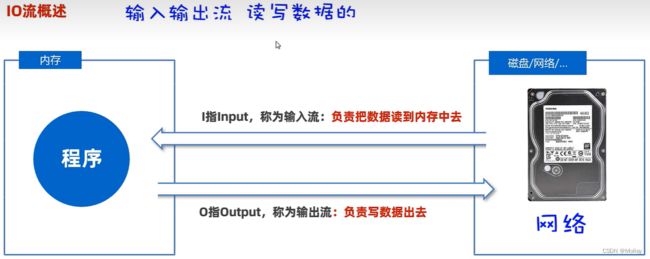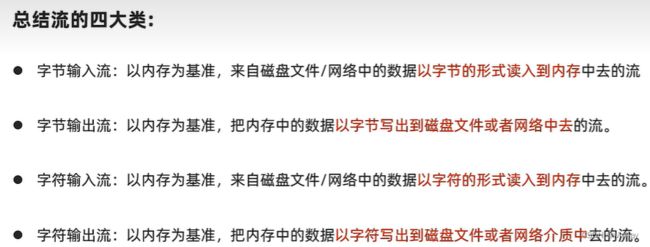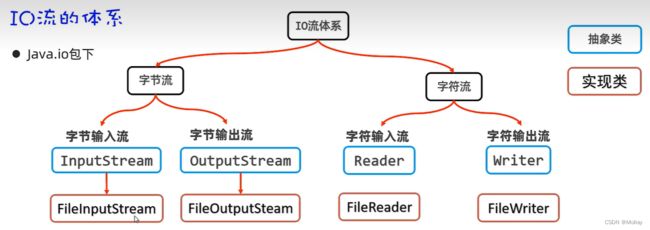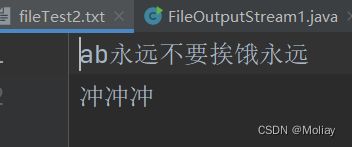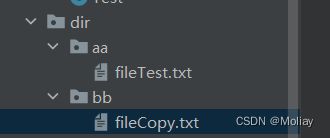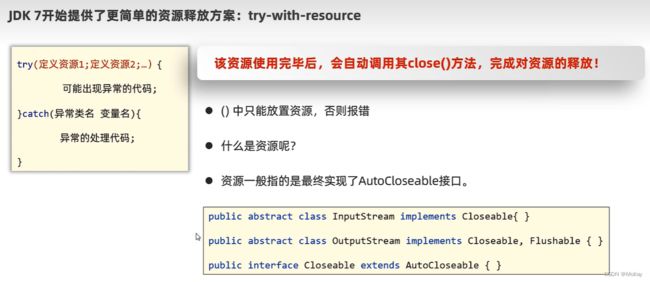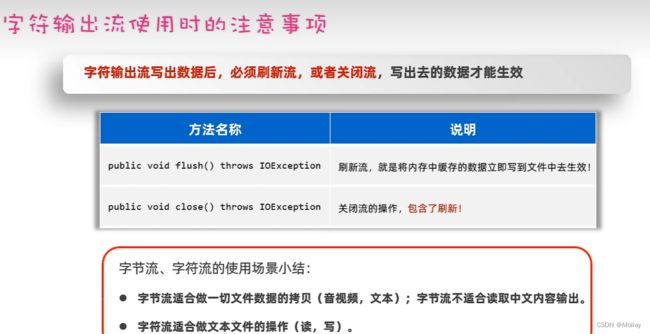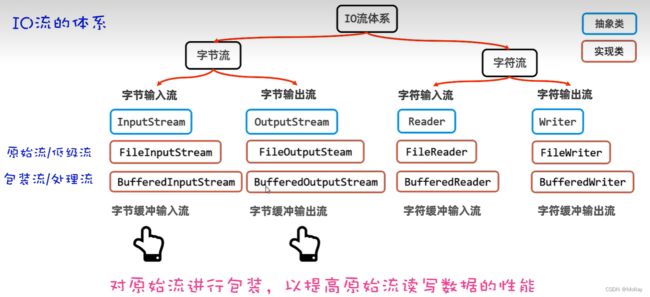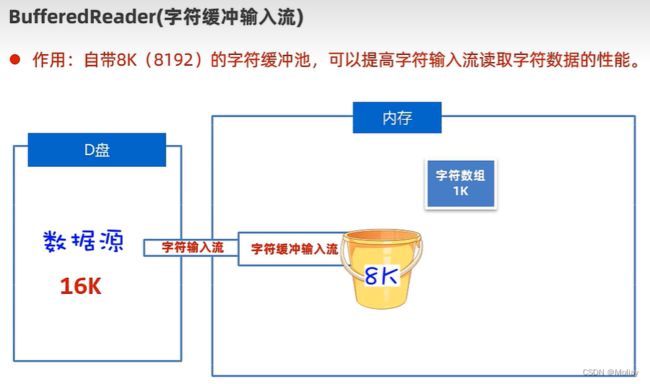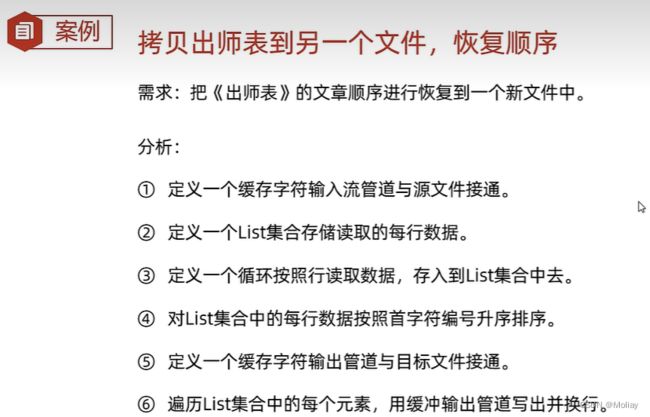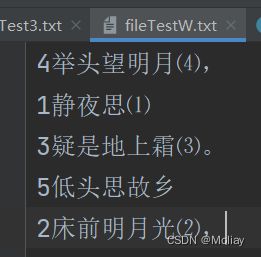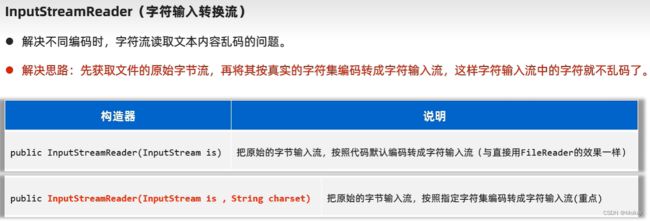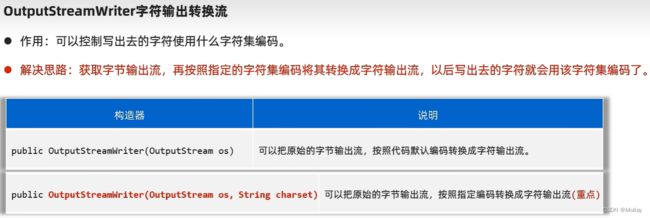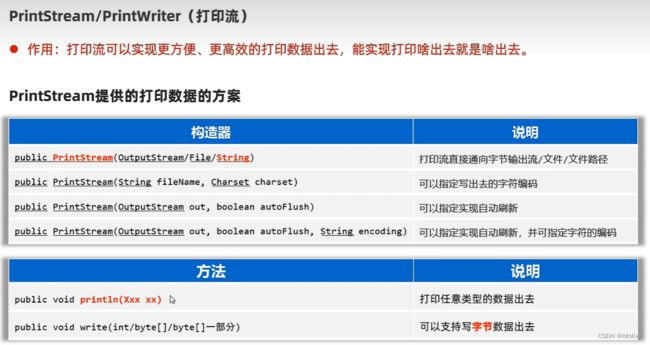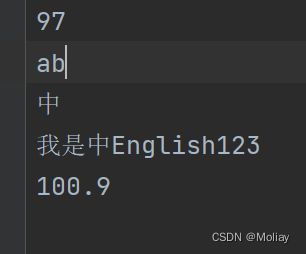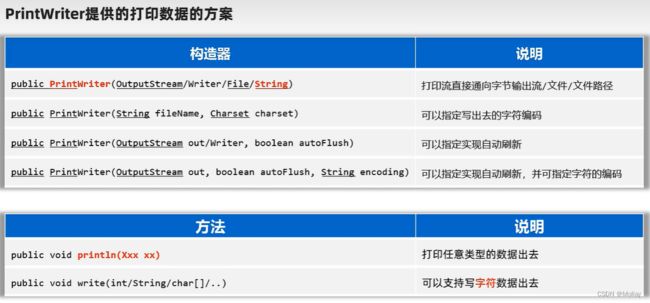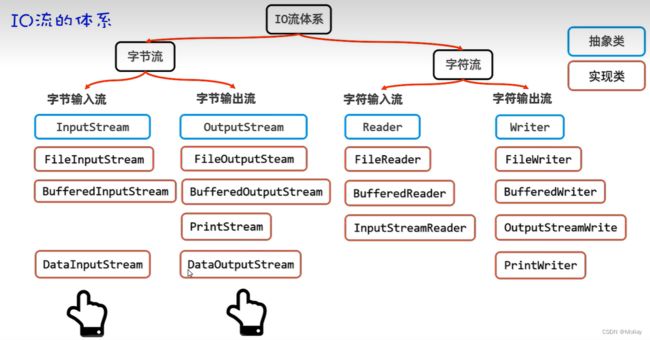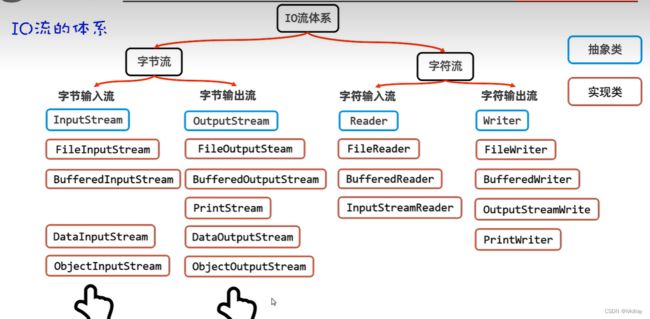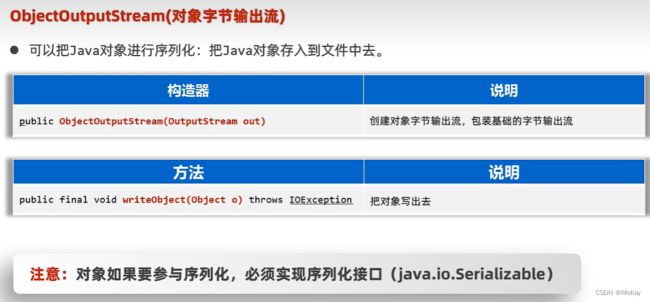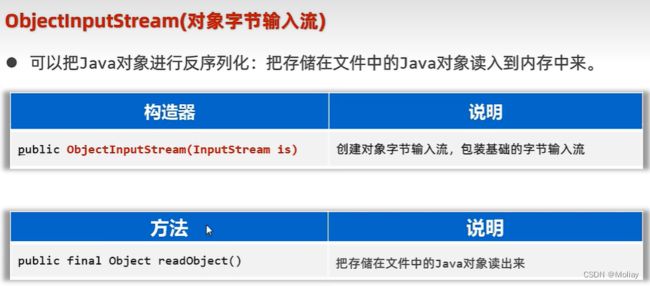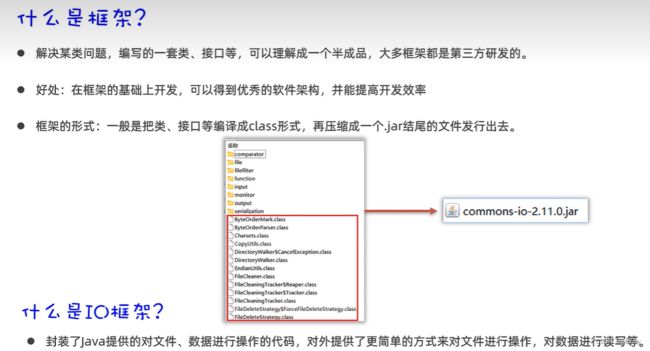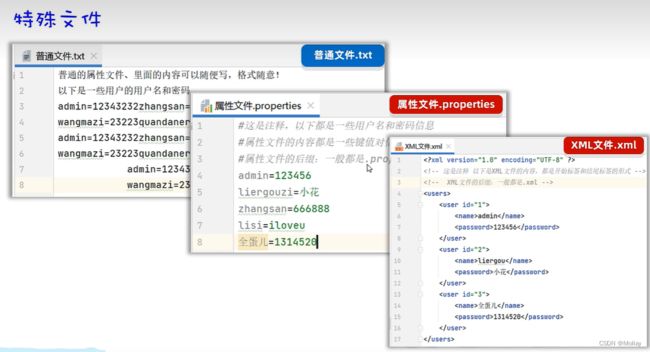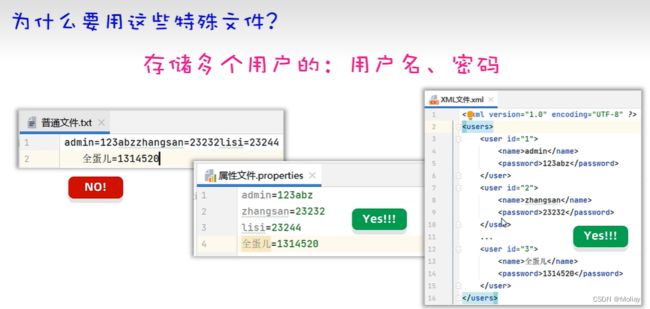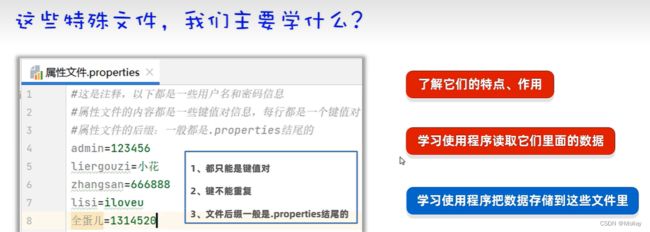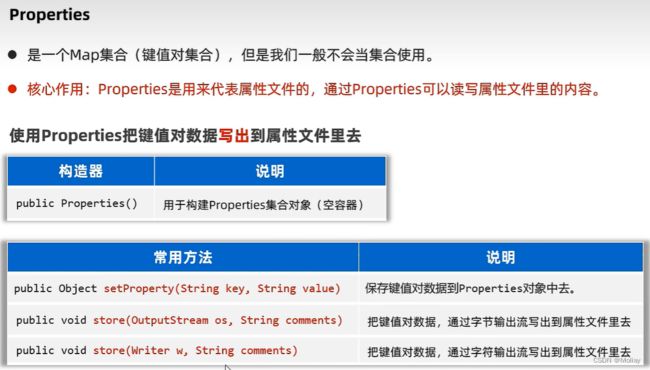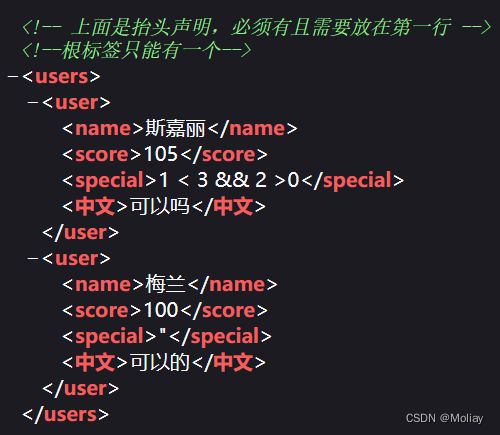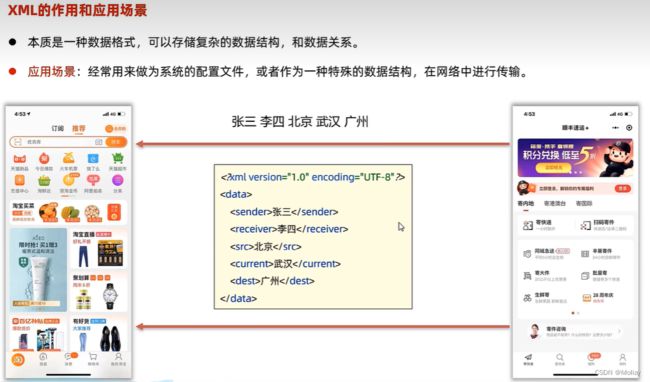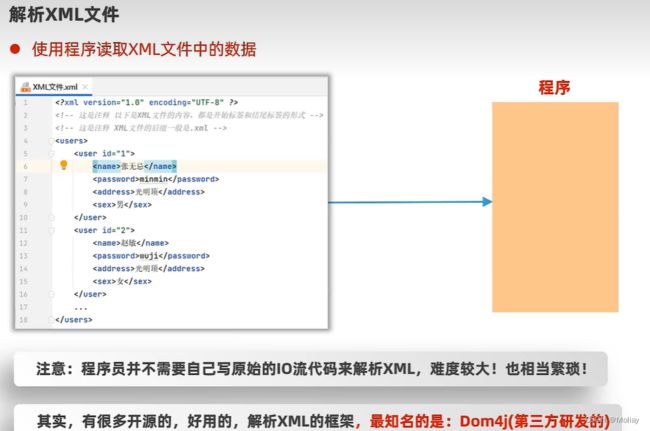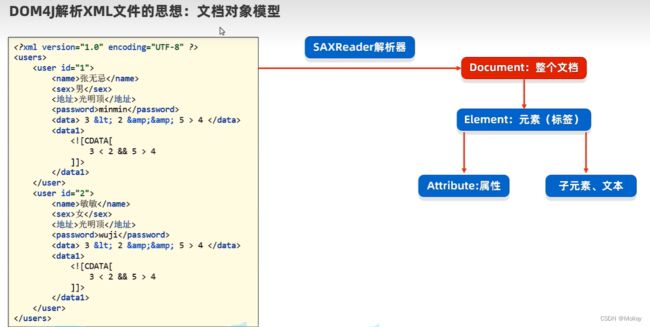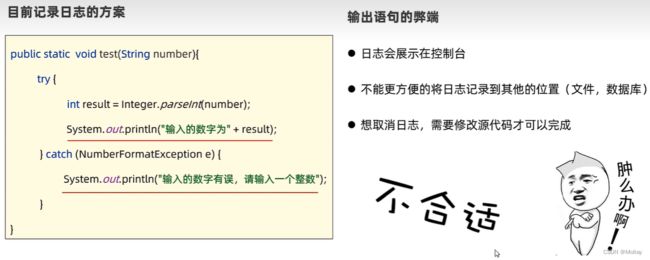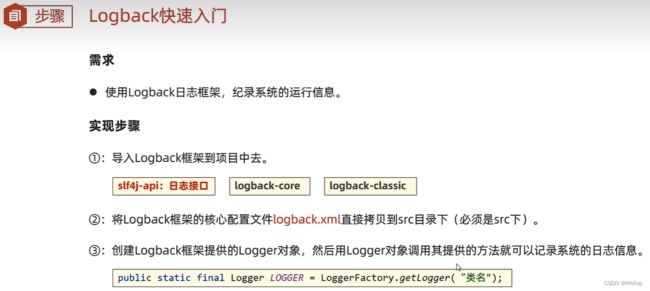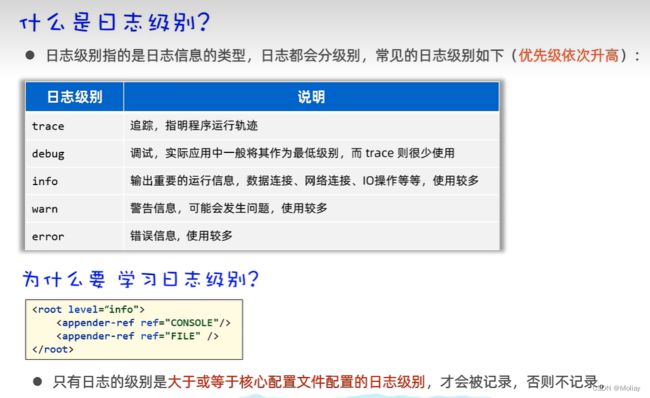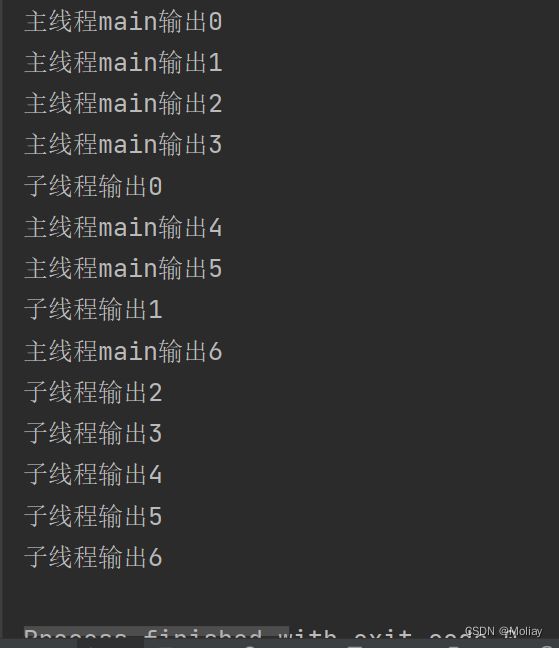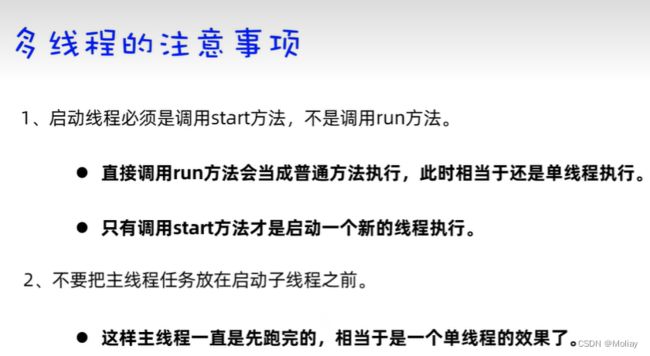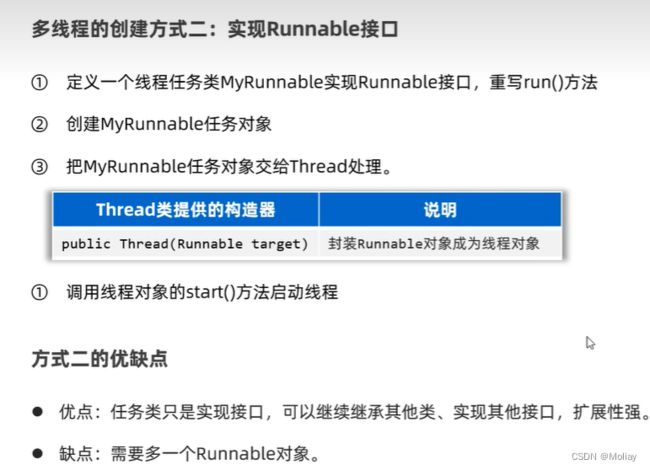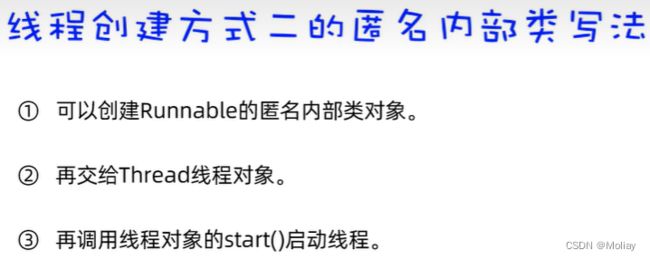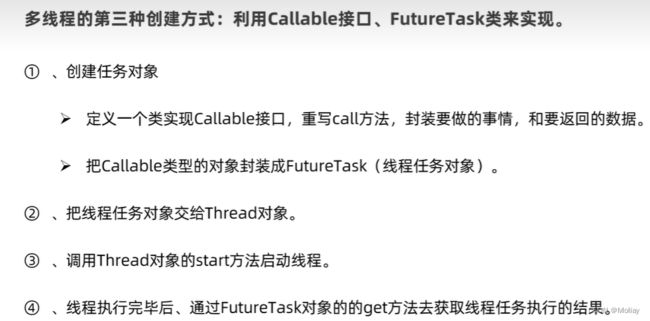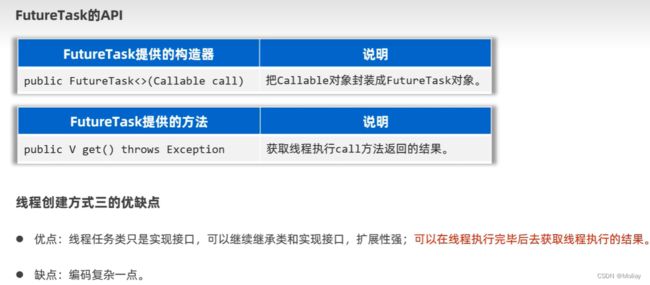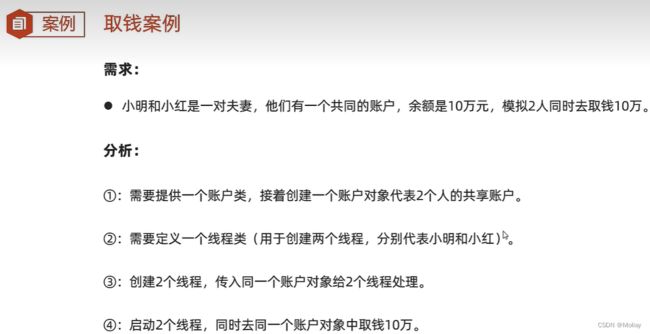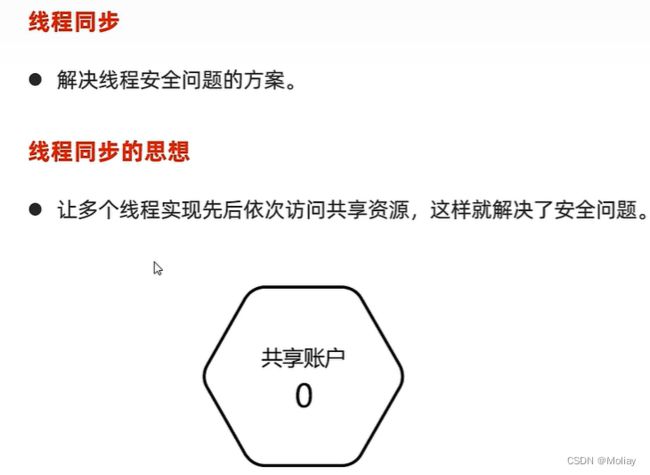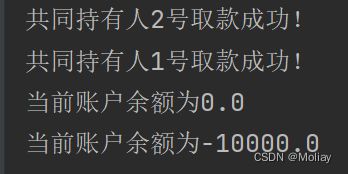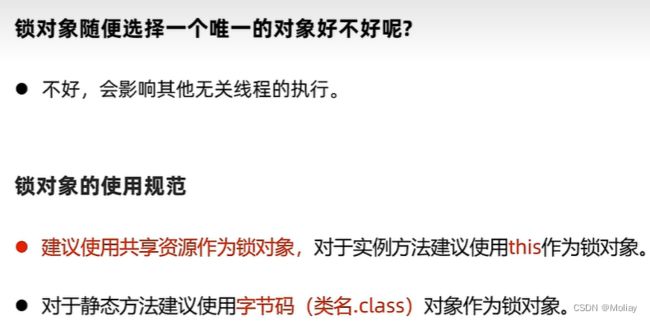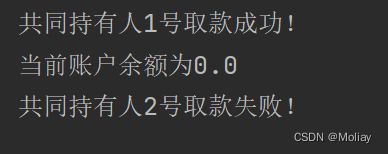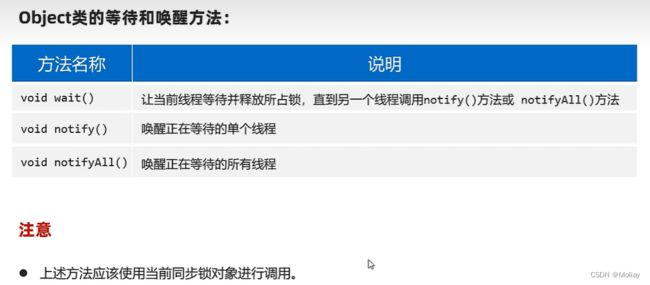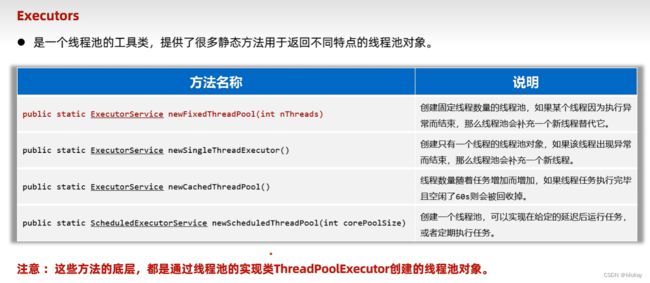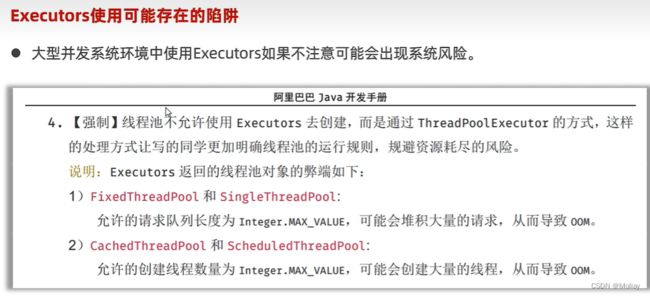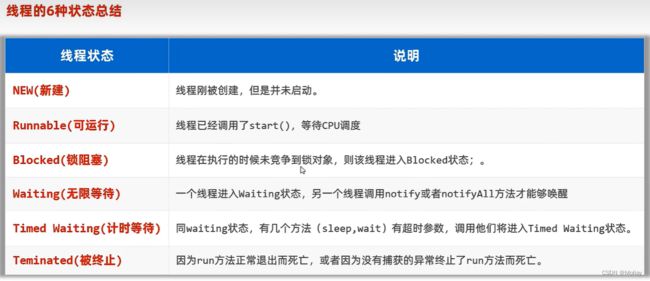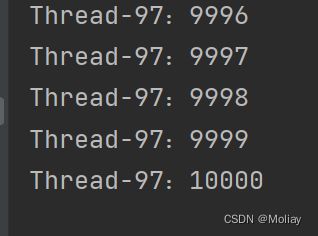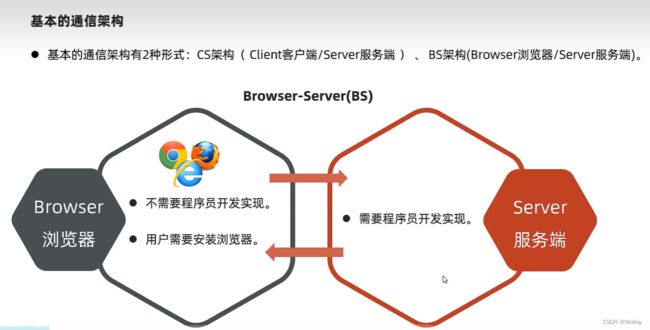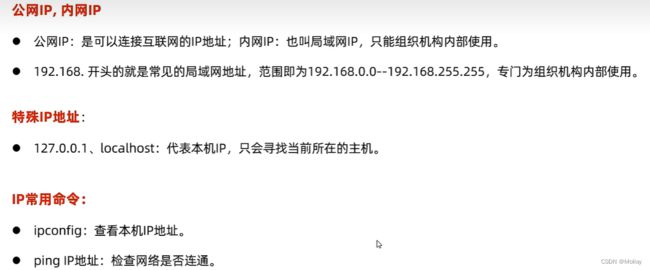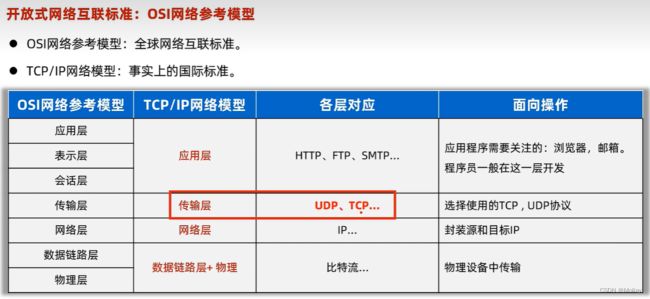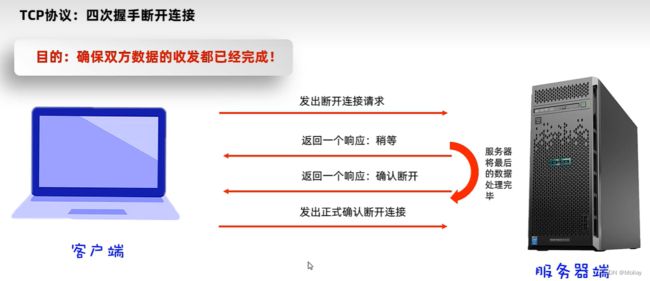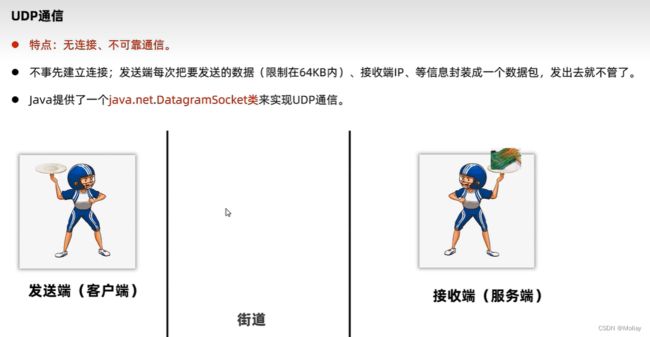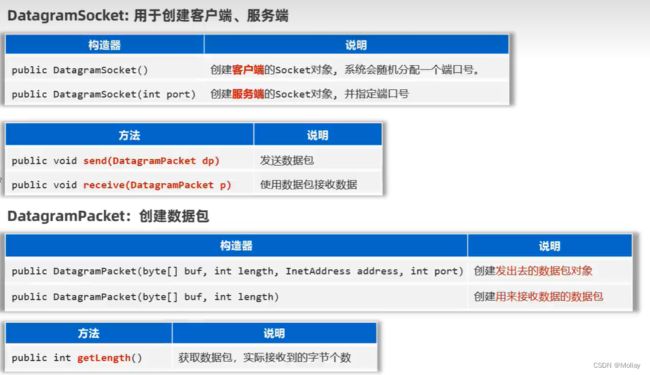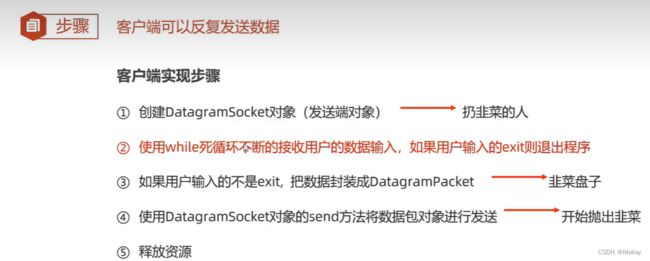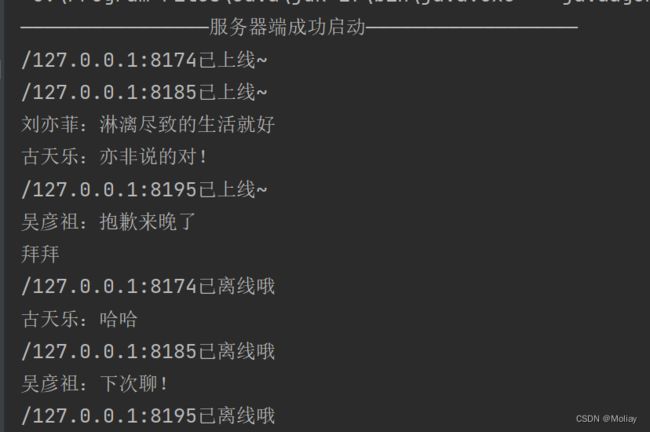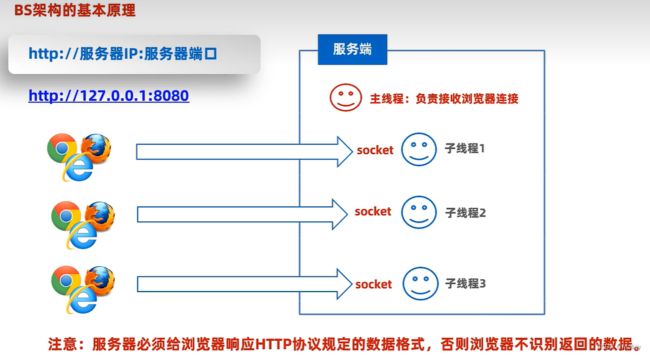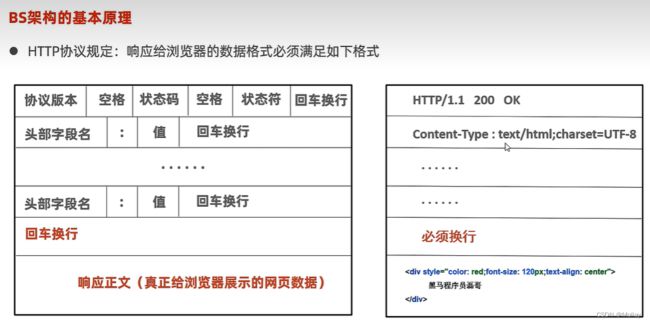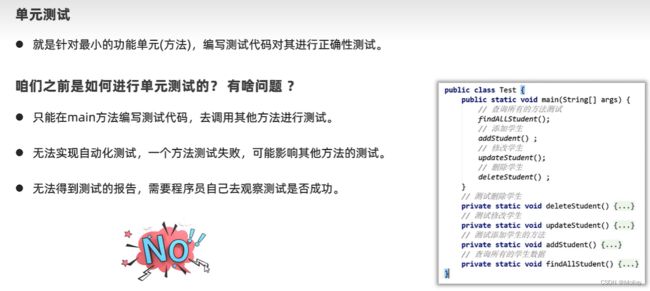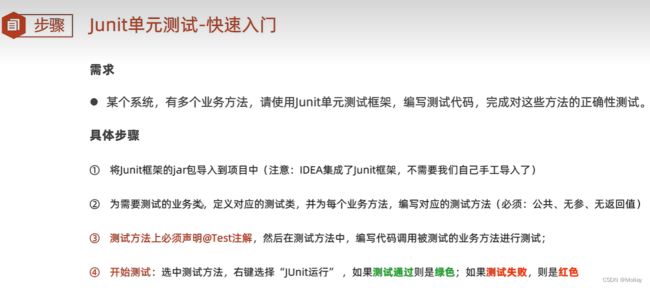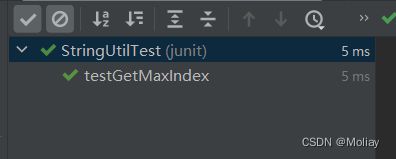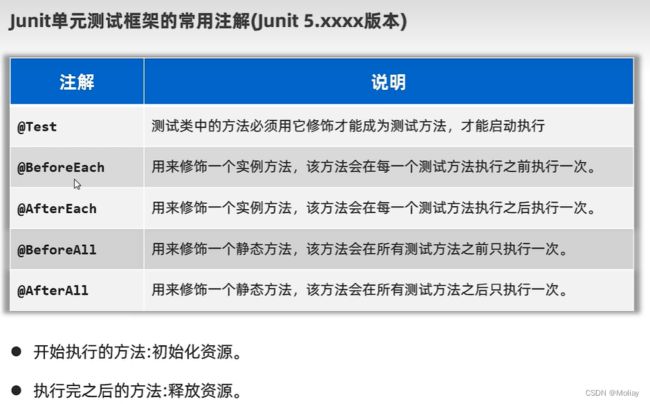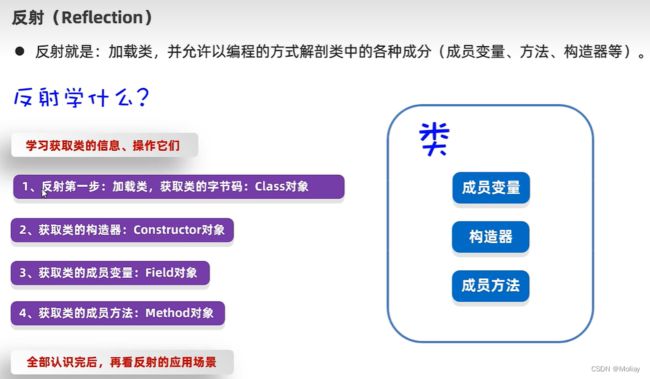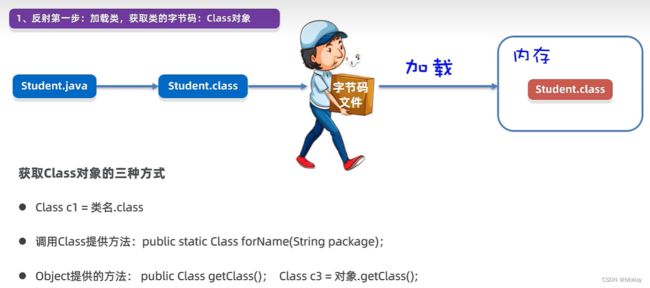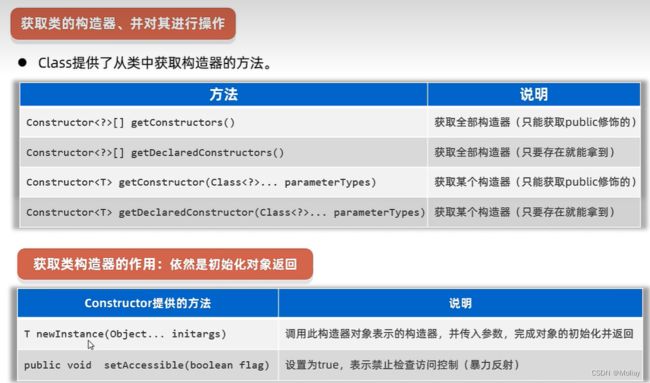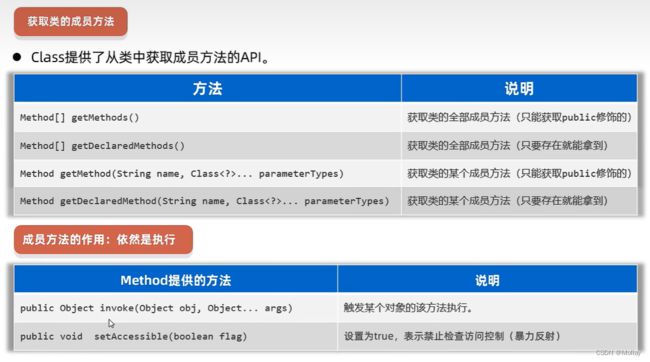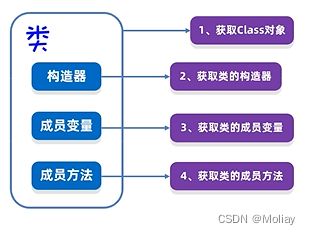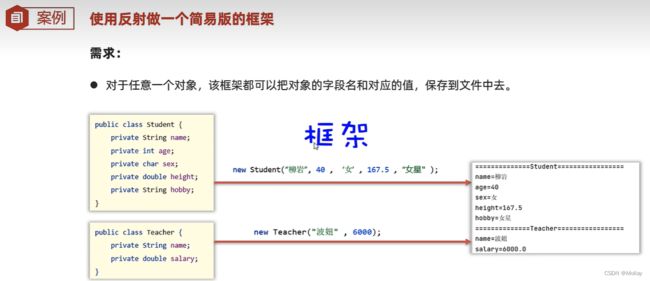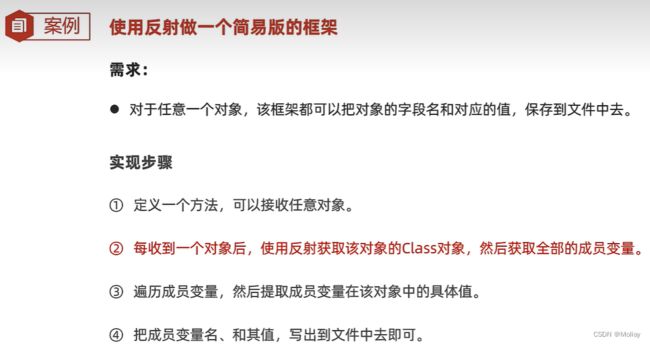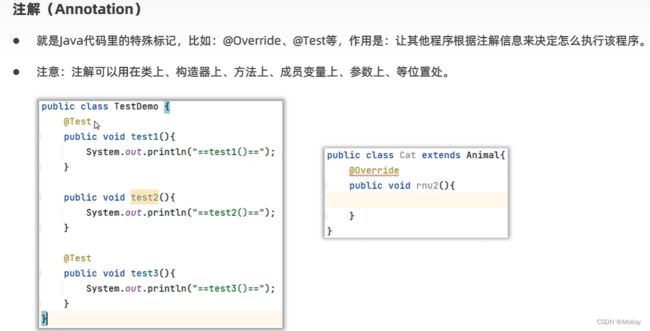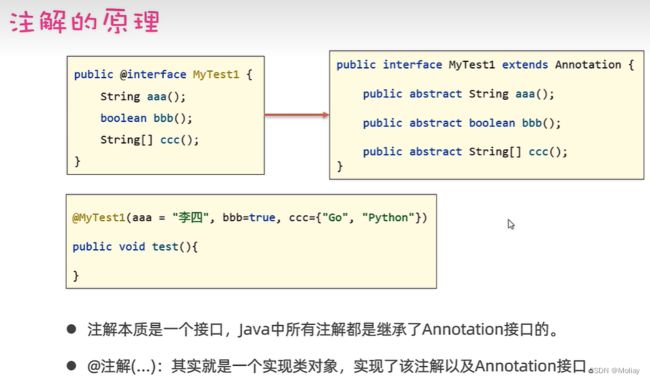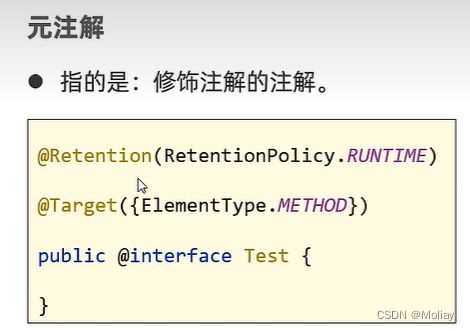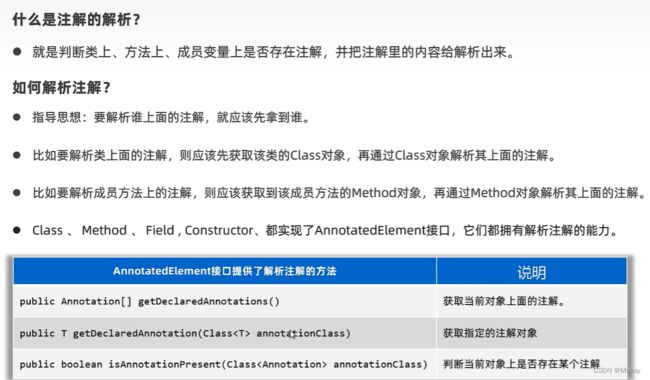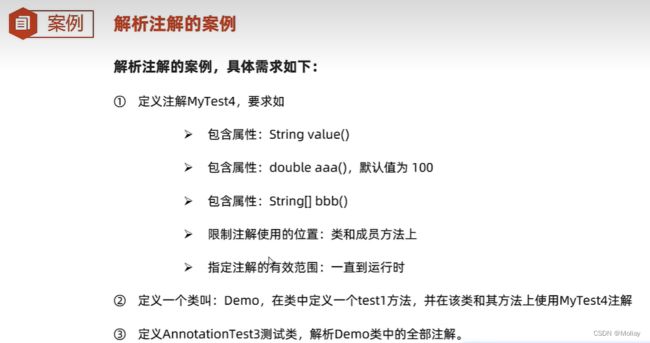Java提高与实践
IO流
IO流概述
- 文件字节输入流:每次读取一个字节
package fileStream;
import java.io.*;
public class HelloFileInputStream {
public static void main(String[] args) throws IOException {
//创建文件字节输入流 管道,与源文件接通
//写法一
//InputStream is = new FileInputStream(new File("IO\\src\\fileTest.txt"));
//写法二
InputStream is = new FileInputStream(("IO\\src\\fileTest.txt"));//文件内容abdc
//开始读取文件的字节数据
//int read()每次读取一个字节返回,若无则返回-1
// int b1 = is.read();
// System.out.println((char)b1);//a
// int b2 = is.read(), b3 = is.read(), b4 = is.read(), b5 = is.read();
// System.out.println((char)b2 +", " + (char)b3 +", " + (char)b4);//b, d, c
// System.out.println(b5);//-1
//从磁盘中读数据,读取性能很差
//读取汉字输出会乱码(汉字是多字节存储,而该方法每次只读取一字节)
//借助循环读取文件内容
int b;
while((b = is.read()) != -1){//abdc
System.out.print((char)b);
}
//流使用完毕后,必须关闭!释放系统资源
is.close();
}
}
- 文件 字节输入流:每次读取多个字节
package fileStream;
import java.io.FileInputStream;
import java.io.FileNotFoundException;
import java.io.IOException;
import java.io.InputStream;
public class FileInputStream1 {
public static void main(String[] args) throws IOException {
InputStream is = new FileInputStream(("IO\\src\\fileTest.txt"));
byte[] buffer = new byte[3];
//int read(byte[] b)每次读取多个字节到字节数组中,返回读取的字节量,读取完毕则返回-1
int len = is.read(buffer);
String s = new String(buffer);
System.out.println(s);//abd
System.out.println("本次读取数据的字节量" + len);//3
// int len1 = is.read(buffer);
// String s1 = new String(buffer);
// System.out.println(s1);//cbd 注意:读取多少,就倒出多少
// System.out.println(len1);//1
int len1 = is.read(buffer);
String s1 = new String(buffer, 0, len1);
System.out.println(s1);//c
System.out.println(len1);//1
int len2 = is.read(buffer);
System.out.println(len2);//-1
is.close();
}
}
package fileStream;
import java.io.FileInputStream;
import java.io.IOException;
import java.io.InputStream;
public class FileInputStream2 {
public static void main(String[] args) throws IOException {
InputStream is = new FileInputStream(("IO\\src\\fileTest1.txt"));//我爱你abca我爱你
byte[] buffer = new byte[3];
int len;
//该方法性能有一定提升,但仍无法解决汉字乱码问题
while((len = is.read(buffer)) != -1){//我爱你abca������
String s = new String(buffer, 0, len);
System.out.print(s);
}
is.close();
}
}
package fileStream;
import java.io.*;
public class FileInputStream3 {
public static void main(String[] args) throws IOException {
InputStream is = new FileInputStream(("IO\\src\\fileTest1.txt"));
File tFile = new File("IO\\src\\fileTest1.txt");
long size = tFile.length();
byte[] buffer = new byte[(int) size];
String s = new String(buffer);
int len = is.read(buffer);
System.out.println(s);//
System.out.println(new String(buffer));//我爱你abca我爱你
System.out.println(len);//22
System.out.println(s.length());//22
}
}
package fileStream;
import java.io.FileInputStream;
import java.io.FileNotFoundException;
import java.io.IOException;
import java.io.InputStream;
public class FileInputStream4 {
public static void main(String[] args) throws IOException {
InputStream is = new FileInputStream(("IO\\src\\fileTest1.txt"));
byte[] buffer = is.readAllBytes();
System.out.println(new String(buffer));//我爱你abca我爱你
is.close();
}
}
package fileStream;
import java.io.FileNotFoundException;
import java.io.FileOutputStream;
import java.io.IOException;
import java.io.OutputStream;
public class FileOutputStream1 {
public static void main(String[] args) throws IOException {
//创建一个字节输出流管道和文件接通
//覆盖管道:覆盖之前的数据内容
OutputStream os = new FileOutputStream("IO\\src\\fileTest2.txt");
os.write(97);
os.write('b');
//os.write('中');默认只能写出去一个字节
byte[] bytes = "永远不要挨饿".getBytes();
os.write(bytes);
os.write(bytes, 0, 6);
os.close();
}
}
package fileStream;
import java.io.FileOutputStream;
import java.io.IOException;
import java.io.OutputStream;
public class FileOutputStream2 {
public static void main(String[] args) throws IOException {
OutputStream os = new FileOutputStream("IO\\src\\fileTest2.txt", true);
os.write("\n冲冲冲".getBytes());
os.close();
}
}
package fileStream;
import java.io.*;
public class CopyFile {
public static void main(String[] args) throws IOException {
InputStream is = new FileInputStream("IO\\src\\dir\\aa\\fileTest.txt");
OutputStream os = new FileOutputStream("IO\\src\\dir\\bb\\fileCopy.txt");
byte[] buffer = new byte[1024];//一般大小为1kb
int len;
while((len = is.read(buffer)) != -1){
os.write(buffer, 0, len);
}
os.close();//流:后创建,先关闭
is.close();
}
}
释放资源
package fileResource;
public class Finally {
public static void main(String[] args) {
try{
System.out.println(10/0);
} catch (Exception e) {
throw new RuntimeException(e);
}
finally代码区:无论try中程序是正常执行还是出现异常,都会执行finally区,除非JVM终止
//作用:一般用于在程序执行完成后进行资源的释放操作(专业级操作)
finally{
System.out.println("finally did");
System.out.println(divide(10, 2));//-1 结果异常==>建议遵循单一出口原则
}
}
public static int divide(int a, int b){
try{
return a / b;
}
catch(Exception e){
e.printStackTrace();
}
finally{
return -1;
}
}
}
package fileStream;
import java.io.*;
public class CopyFile {
public static void main(String[] args) throws IOException {
InputStream is = null;
OutputStream os= null;
try {
is = new FileInputStream("IO\\src\\dir\\aa\\fileTest.txt");
os = new FileOutputStream("IO\\src\\dir\\bb\\fileCopy.txt");
byte[] buffer = new byte[1024];//一般大小为1kb
int len;
while((len = is.read(buffer)) != -1){
os.write(buffer, 0, len);
}
} catch (IOException e) {
throw new RuntimeException(e);
} finally {
try {
if(os != null) os.close();//流:后创建,先关闭
} catch (IOException e) {
throw new RuntimeException(e);
}
try {
if(is != null) is.close();
} catch (IOException e) {
throw new RuntimeException(e);
}
}
}
}
package fileStream;
import java.io.*;
public class CopyFile1 {
public static void main(String[] args) throws IOException {
try(
//只能放资源对象(流对象)(资源对象都会实现AutoCloseable接口)
//AutoCloseable接口有close()方法,故每个资源都会有一个close()方法,用完后进行自动调用
InputStream is = new FileInputStream("IO\\src\\dir\\aa\\fileTest.txt");
OutputStream os = new FileOutputStream("IO\\src\\dir\\bb\\fileCopy.txt");
MyConllection con = new MyConllection();
){
byte[] buffer = new byte[1024];//一般大小为1kb
int len;
while((len = is.read(buffer)) != -1){
os.write(buffer, 0, len);
}
System.out.println(con);
} catch (Exception e) {
throw new RuntimeException(e);
}
}
}
package fileStream;
public class MyConllection implements AutoCloseable{
@Override
public void close() throws Exception {
System.out.println("释放了和某硬件连接的资源~");
}
}
字符流
package file;
import java.io.FileReader;
import java.io.Reader;
public class HelloFileReader {
public static void main(String[] args) {
try(
Reader fr = new FileReader("IO\\src\\fileTest.txt");
){
int count;
//每次只读一个字符,性能较差
while((count = fr.read()) != -1){
System.out.print((char)count);
}
}catch(Exception e){
e.printStackTrace();
}
}
}
package file;
import java.io.FileReader;
import java.io.Reader;
public class HelloFileReader1 {
public static void main(String[] args) {
try(
Reader fr = new FileReader("IO\\src\\fileTest.txt");
){
char[] buffer = new char[3];
int count;
while((count = fr.read(buffer)) != -1){
//System.out.println(new String(buffer, 0, count));
System.out.print(new String(buffer, 0, count));
}
}catch(Exception e){
e.printStackTrace();
}
}
}
package file;
import java.io.FileWriter;
import java.io.Writer;
public class HelloFileWriter {
public static void main(String[] args) {
try(
//覆盖管道
Writer fw = new FileWriter("IO\\src\\fileTest3.txt")
) {
fw.write(97);
fw.write('b');
fw.write('中');
fw.write("我是字符串");
fw.write("\n");
fw.write("\r\n");//换行
char[] arr = {'我', '是', '字', 'f', 'u'};
fw.write(arr, 0, arr.length);
fw.write("\r\n");
fw.write(arr, 0, 2);
}catch(Exception e){
e.printStackTrace();
}
}
}
package file;
import java.io.FileWriter;
import java.io.Writer;
public class HelloWrite {
public static void main(String[] args) {
try(
//追加管道
Writer fw = new FileWriter("IO\\src\\fileTest3.txt", true) ;
){
fw.write("\r\n我是追加内容");
}catch(Exception e){
e.printStackTrace();
}
}
}
缓冲区已满时,会自动刷新和写入数据
fw.flush();//刷新流(关闭流中包含刷新流)
缓冲流
package buffer;
import java.io.*;
public class HelloBufferedInputStream {
public static void main(String[] args){
try(
InputStream is = new FileInputStream("IO\\src\\fileTest.txt");
InputStream bis = new BufferedInputStream(is);
OutputStream os = new FileOutputStream("IO\\src\\fileTest1.txt");
OutputStream bos = new BufferedOutputStream(os);
){
byte[] buffer = new byte[1024];
int len;
while((len = bis.read(buffer)) != -1){
bos.write(buffer, 0, len);
}
}catch(Exception e){
e.printStackTrace();
}
}
}
package buffer;
import java.io.BufferedReader;
import java.io.FileReader;
import java.io.Reader;
public class HelloBufferedReader {
public static void main(String[] args){
try(
Reader r = new FileReader("IO\\src\\fileTest.txt");
BufferedReader br = new BufferedReader(r);
){
char[] buffer = new char[3];
int len;
while((len = br.read(buffer)) != -1){
System.out.print(new String(buffer, 0,len));
}
}catch(Exception e){
e.printStackTrace();
}
}
}
package buffer;
import java.io.BufferedReader;
import java.io.FileReader;
import java.io.Reader;
public class HelloBufferedReader1 {
public static void main(String[] args){
try(
Reader r = new FileReader("IO\\src\\fileTest.txt");
BufferedReader br = new BufferedReader(r);
){
String line;//记住每次读取的一行数据
while((line = br.readLine()) != null){
System.out.println(line);
}
}catch(Exception e){
e.printStackTrace();
}
}
}
package buffer;
import java.io.BufferedWriter;
import java.io.FileWriter;
import java.io.Writer;
public class HelloBufferedWriter {
public static void main(String[] args){
try(
Writer w = new FileWriter("IO\\src\\dir\\fileTestW.txt");
BufferedWriter bw = new BufferedWriter(w);
){
bw.write(97);
bw.write('b');
bw.write('中');
bw.newLine();//换行
bw.write("我是字符串吖");
}catch(Exception e){
e.printStackTrace();
}
}
}
简单应用:拷贝文件内容到另一个文件,并对内容排序
package buffer;
import java.io.*;
import java.util.ArrayList;
import java.util.Arrays;
import java.util.List;
public class Apply {
public static void main(String[] args){
try(
Writer w = new FileWriter("IO\\src\\dir\\fileTestCopy.txt");
BufferedWriter bw = new BufferedWriter(w);
Reader r = new FileReader("IO\\src\\dir\\fileTestW.txt");
BufferedReader br = new BufferedReader(r);
){
List<String> list = new ArrayList<>();
String line;
while((line = br.readLine()) != null){
list.add(new String(line));
}
list.sort(((o1, o2) -> o1.compareTo(o2)));
//System.out.println(list);[1静夜思⑴, 2床前明月光⑵,, 3疑是地上霜⑶。, 4举头望明月⑷,, 5低头思故乡]
for(String s : list){
bw.write(s);
}
}catch(Exception e){
e.printStackTrace();
}
}
}
package buffer;
import java.io.*;
import java.util.ArrayList;
import java.util.Arrays;
import java.util.Collections;
import java.util.List;
public class Apply1 {
public static void main(String[] args){
try(
BufferedWriter bw = new BufferedWriter(new FileWriter("IO\\src\\dir\\fileTestCopy.txt"));
BufferedReader br = new BufferedReader(new FileReader("IO\\src\\dir\\fileTestW.txt"));
){
List<String> list = new ArrayList<>();
String line;
while((line = br.readLine()) != null){
list.add(new String(line));
}
Collections.sort(list);
//System.out.println(list);[1静夜思⑴, 2床前明月光⑵,, 3疑是地上霜⑶。, 4举头望明月⑷,, 5低头思故乡]
for(String s : list){
bw.write(s);
bw.newLine();
}
}catch(Exception e){
e.printStackTrace();
}
}
}
原始流和缓冲流的性能分析
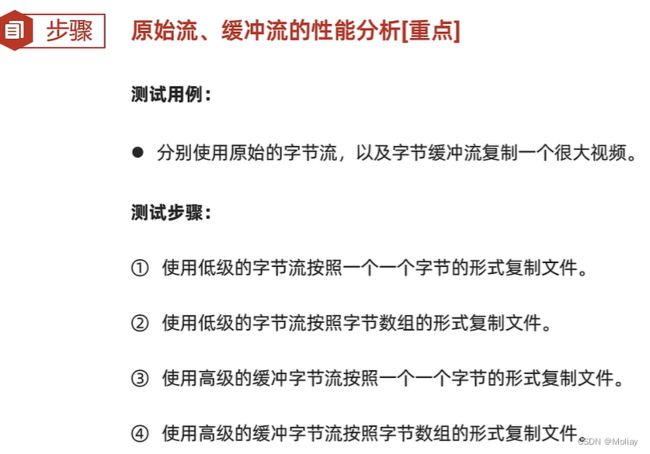
在一定范围内,内存越大越好;
到达极限后,内存已经最优化之后再增加也不会有效提高速度

转换流
package transform;
import java.io.*;
public class HeyInputStreamReader {
public static void main(String[] args){
try(
Reader isr = new InputStreamReader(new FileInputStream("IO\\src\\dir\\fileTestW.txt"), "GBK");
BufferedReader bs = new BufferedReader(isr);
){
String line;
while((line = bs.readLine()) != null){
System.out.println(line);
}
}catch(Exception e){
}
}
}
package transform;
import java.io.*;
public class HeyOutputStreamWriter {
public static void main(String[] args){
try(
Writer w = new OutputStreamWriter(new FileOutputStream("IO\\src\\dir\\fileTestTrans.txt"), "GBK");
BufferedWriter bw = new BufferedWriter(w);
){
bw.write("I am English123");
bw.write("我是中文456");
}catch(Exception e){
e.printStackTrace();
}
}
}
打印流
package printStream;
import java.io.PrintStream;
import java.nio.charset.Charset;
public class HelloPrintStream {
public static void main(String[] args){
try(
PrintStream ps = new PrintStream("IO\\src\\dir\\filePrint.txt", Charset.forName("GBK"));
){
ps.println(97);
ps.write(97);
ps.println('b');
ps.println('中');
ps.println("我是中English123");
ps.println(100.9);
}catch(Exception e){
e.printStackTrace();
}
}
}
package printStream;
import java.io.PrintStream;
import java.io.PrintWriter;
import java.nio.charset.Charset;
public class HelloPrintWriter {
public static void main(String[] args){
try(
PrintWriter ps = new PrintWriter("IO\\src\\dir\\filePrint1.txt", Charset.forName("GBK"));
){
ps.println(97);
ps.write(97);
ps.println('b');
ps.println('中');
ps.println("我是中English123");
ps.println(100.9);
}catch(Exception e){
e.printStackTrace();
}
}
}
package printStream;
import java.io.FileOutputStream;
import java.io.PrintStream;
import java.io.PrintWriter;
import java.nio.charset.Charset;
public class HelloPrintWriter {
public static void main(String[] args){
try(//追加数据需要借助低级流实现
PrintWriter ps = new PrintWriter(new FileOutputStream("IO\\src\\dir\\filePrint1.txt", true));
){
ps.println(97);
ps.write(97);
ps.println('b');
ps.println('中');
ps.println("我是中English123");
ps.println(100.9);
}catch(Exception e){
e.printStackTrace();
}
}
}
打印流的应用:输出语句的重定向
package printStream;
import java.io.PrintStream;
public class Apply {
public static void main(String[] args) {
System.out.println("生如夏花");
try(
PrintStream ps = new PrintStream("IO\\src\\dir\\filePrint2.txt");
){
System.setOut(ps);
System.out.println("直挂云帆济沧海");
}catch(Exception e){
e.printStackTrace();
}
}
}
数据流
package dataStream;
import java.io.DataOutputStream;
import java.io.FileOutputStream;
public class HeyDataOutputStream {
public static void main(String[] args){
try(DataOutputStream dos = new DataOutputStream(new FileOutputStream("IO\\src\\dir\\dataStreamW.txt"));){
dos.writeInt(97);
dos.writeBoolean(true);
dos.writeUTF("字符串");
dos.writeDouble(100.1);
}catch(Exception e){
e.printStackTrace();
}
}
}
package dataStream;
import java.io.DataInputStream;
import java.io.FileInputStream;
public class HeyDataInputStream {
public static void main(String[] args){
try(DataInputStream dis = new DataInputStream(new FileInputStream("IO\\src\\dir\\dataStreamW.txt"))){
System.out.println(dis.readInt());//97
System.out.println(dis.readBoolean());//true
System.out.println(dis.readUTF());//字符串
System.out.println(dis.readDouble());//100.1
}catch(Exception e){
e.printStackTrace();
}
}
}
序列化流
package objectStream;
import java.io.FileOutputStream;
import java.io.ObjectOutputStream;
public class HeyObjectOutputStream {
public static void main(String[] args){
try(ObjectOutputStream oos = new ObjectOutputStream(new FileOutputStream("IO\\src\\dir\\objectStream.txt"))){
Student s = new Student("刘亦菲", 26, 100.1);
oos.writeObject(s);
}catch(Exception e){
e.printStackTrace();
}
}
}
package objectStream;
import java.io.Serializable;
public class Student implements Serializable {
private String name;
private int age;
private double score;
public Student() {
}
public Student(String name, int age, double score) {
this.name = name;
this.age = age;
this.score = score;
}
public String getName() {
return name;
}
public void setName(String name) {
this.name = name;
}
public int getAge() {
return age;
}
public void setAge(int age) {
this.age = age;
}
public double getScore() {
return score;
}
public void setScore(double score) {
this.score = score;
}
@Override
public String toString() {
return "Student{" +
"name='" + name + '\'' +
", age=" + age +
", score=" + score +
'}';
}
}
package objectStream;
import java.io.FileInputStream;
import java.io.ObjectInputStream;
public class HeyObjectInputStream {
public static void main(String[] args){
try(ObjectInputStream ois = new ObjectInputStream(new FileInputStream("IO/src/dir/objectStream.txt"))){
// Student s = (Student) ois.readObject();
// System.out.println(s);//Student{name='刘亦菲', age=26, score=100.1}
System.out.println(ois.readObject());//Student{name='刘亦菲', age=26, score=100.1}
}catch(Exception e){
e.printStackTrace();
}
}
}
//transient修饰后,表示该成员变量不参与序列化
private transient double score;
IO框架
package commonsIO;
import org.apache.commons.io.FileUtils;
import java.io.File;
import java.io.IOException;
public class Test {
public static void main(String[] args) throws IOException {
//复制文件
FileUtils.copyFile(new File("IO/src/dir/fileTestCopy.txt"), new File("IO/src/dir/helloCommons.txt"));
//复制文件夹
FileUtils.copyDirectory(new File("IO/src/dir/aa"), new File("IO/src/dir/cc"));
//删除文件夹(可直接删除非空文件夹)
FileUtils.deleteDirectory(new File("IO/src/dir/aa"));
}
}
package commonsIO;
import java.io.IOException;
import java.nio.file.Files;
import java.nio.file.Path;
public class TestJavaself {
public static void main(String[] args) throws IOException {
//Java提供的高效原生代码
Files.copy(Path.of("IO/src/dir/bb/fileCopy.txt"), Path.of("IO/src/dir/cc/fileCopyC.txt"));
System.out.println(Files.readString(Path.of("IO/src/dir/cc/fileTest.txt")));
}
}
特殊文件
properties属性文件
package specialFile;
import java.io.FileNotFoundException;
import java.io.FileReader;
import java.io.IOException;
import java.util.Properties;
import java.util.Set;
public class HelloProperties {
public static void main(String[] args) throws IOException {
//创建Properties对象(键值对集合的空容器)
Properties p = new Properties();
System.out.println(p);
//加载属性文件中的键值对信息到Properties对象中
p.load(new FileReader("IO\\src\\users.properties"));
System.out.println(p);
//根据键 取值
System.out.println(p.getProperty("summer"));
System.out.println(p.getProperty("rick"));
//遍历全部的键和值
Set<String> users = p.stringPropertyNames();
for(String s : users){
String value = p.getProperty(s);
System.out.println(s + ":" + value);
}
System.out.println();
p.forEach((k, v) -> System.out.println(k + ":" + v));
}
}
package specialFile;
import java.io.FileWriter;
import java.io.IOException;
import java.util.Properties;
public class Properties1 {
public static void main(String[] args) throws IOException {
Properties p = new Properties();
p.setProperty("jerry", "5555");
p.setProperty("morty", "6666");
//覆盖式存入
p.store(new FileWriter("IO/src/users.properties"), "save more users");
}
}
简单应用:![]()
package specialFile;
import java.io.*;
import java.util.Properties;
public class Apply {
public static void main(String[] args) throws IOException {
Properties p = new Properties();
p.load(new FileReader("IO\\src\\users.properties"));
if(p.containsKey("jerry")){
p.setProperty("jerry", "6666");
}
p.store(new FileWriter("IO/src/users.properties"), "modify jerry password");
}
}
XML文件
<users>
<user>
<name>斯嘉丽name>
<score>105score>
<special>1 < 3 && 2 >0special>
<中文>可以吗中文>
user>
<user>
<name>梅兰name>
<score>100score>
<special>"special>
<中文>可以的中文>
user>
users>
解析XML文件
dom4j下载地址(下载首个jar包即可,若想了解源码则下载第二个source,若想了解使用说明则下载第三个)
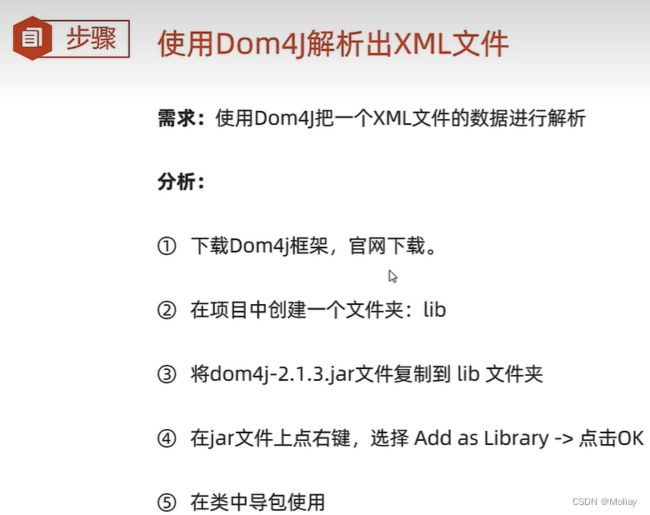
package dom4jTest;
import org.dom4j.Document;
import org.dom4j.DocumentException;
import org.dom4j.Element;
import org.dom4j.io.SAXReader;
import javax.xml.parsers.SAXParser;
import java.util.Arrays;
import java.util.List;
public class HelloSAX {
public static void main(String[] args) throws DocumentException {
//创建一个dom4j框架提供的解析器对象
SAXReader saxReader = new SAXReader();
//使用SAXReader对象把要解析的XMl文件读成一个document对象
Document document = saxReader.read("IO\\src\\helloWorld.xml");
//从Document对象中读取XML中的全部数据元素
Element root = document.getRootElement();
System.out.println(root.getName());//users
//List elements()获取当前元素下的所有子元素
List<Element> elements = root.elements();
for (Element element : elements) {
System.out.println(element.getName());
}
System.out.println();
//List elements(String name)获取当前元素下 指定名字的子元素集合
List<Element> elements1 = root.elements("user");
elements1.forEach(o1 -> System.out.println(o1.getName()));
//Element element(String name)获取当前元素下指定名字的子元素,若有重复则返回首次出现的
//String getText()得到文本内容
Element element = root.element("visitor");
System.out.println(element.getText());//会话访问
//String attributeValues(String name)通过属性名直接获得属性值
System.out.println(root.attributeValue("num"));//4
}
}
XML文件的生成
package xml;
import java.io.BufferedWriter;
import java.io.FileWriter;
public class WriteIn {
public static void main(String[] args){
//使用StringBuilder对象来拼接XML格式的数据
StringBuilder sb = new StringBuilder();
sb.append("\r\n");
sb.append("\r\n" );
sb.append("\t1 \r\n");
sb.append("\t乱世佳人 \r\n");
sb.append("");
try(
BufferedWriter bw = new BufferedWriter(new FileWriter("IO\\src\\testW.xml"))
){
bw.write(sb.toString());
}catch(Exception e){
e.printStackTrace();
}
}
}
约束XML文件的编写(简单了解)
日志技术
体系结构
Logback
package log;
import org.slf4j.Logger;
import org.slf4j.LoggerFactory;
import java.util.Scanner;
public class Hello {
public static final Logger LOGGER = LoggerFactory.getLogger("logTest1");
public static void main(String[] args) {
try {
LOGGER.info("程序开始执行~");
Scanner sc = new Scanner(System.in);
int m = sc.nextInt(), n = sc.nextInt();
divide(m, n);
LOGGER.info("程序成功执行完毕~");
} catch (Exception e) {
LOGGER.error("程序执行异常");
}
}
public static void divide(int m, int n){
LOGGER.debug("参数m:" + m);
LOGGER.debug("参数n" + n);
System.out.println(m / n);
LOGGER.info("结果是" + m / n);
}
}
logback核心配置文件
多线程
线程创建方式
创建方式1:继承Thread类
package thread;
public class HelloThread {
//main()方法由默认的主线程负责执行
public static void main(String[] args) {
//创建一个MyThread线程类对象代表一个线程
Thread thread = new MyThread();
thread.start();//启动线程,自动执行run()方法
for (int i = 0; i < 7; i++) {
System.out.println("主线程main输出" + i);
}
}
}
package thread;
public class MyThread extends Thread{//子类继承Thread线程类
@Override
public void run(){//需要重写Thread类的run()方法
//描述线程的执行任务
for (int i = 0; i < 7; i++) {
System.out.println("子线程输出" + i);
}
}
}
创建方式2:实现Runnable接口
package thread;
public class HelloThread {
//main()方法由默认的主线程负责执行
public static void main(String[] args) {
//创建任务对象
MyRunnable myRunnable = new MyRunnable();
new Thread(myRunnable).start();//把任务对象交给一个线程对象来处理
for (int i = 0; i < 7; i++) {
System.out.println("主线程main输出" + i);
}
}
}
package thread;
public class MyRunnable implements Runnable{
@Override
public void run() {
//线程要执行的任务
for (int i = 0; i < 7; i++) {
System.out.println("子线程输出" + i);
}
}
}
package thread;
public class HelloThread {
//main()方法由默认的主线程负责执行
public static void main(String[] args) {
//简化1:匿名内部类写法
Runnable runnable1 = new Runnable() {
@Override
public void run() {
for (int i = 0; i < 7; i++) {
System.out.println("子线程1输出" + i);
}
}
};
new Thread(runnable1).start();
//简化版本2
new Thread(new Runnable() {
@Override
public void run() {
for(int i = 0; i < 7; i++){
System.out.println("子线程2输出" + i);
}
}
}).start();
//简化版本3(Lambda表达式)
new Thread(() ->
{
for (int i = 0; i < 7; i++) {
System.out.println("子线程3输出" + i);
}
}).start();
for (int i = 0; i < 7; i++) {
System.out.println("主线程main输出" + i);
}
}
}
创建方式3:实现Callable接口
package thread;
import java.util.concurrent.Callable;
import java.util.concurrent.ExecutionException;
import java.util.concurrent.FutureTask;
public class HelloThread {
//main()方法由默认的主线程负责执行
public static void main(String[] args) throws ExecutionException, InterruptedException {
Callable<String> call = new MyCallable(10);//创建Callable对象
//FutureTask对象 :一个任务对象,实现了Runnable接口;在线程执行完后,用get方法获取线程执行结果
FutureTask<String> futureTask = new FutureTask<>(call);//把Callable对象封装为FutureTask对象
//把任务对象交给一个Thread对象
new Thread(futureTask).start();
//获取线程执行完毕的结果
System.out.println(futureTask.get());
}
}
![]()
Thread常用方法
package thread;
public class HeyThread {
public static void main(String[] args) {
MyThread thread1 = new MyThread();
thread1.start();
//String getName()获取当前线程的名称,线程名默认是Thread-索引
System.out.println(thread1.getName());//Thread-0
MyThread thread2 = new MyThread();
thread2.start();
System.out.println(thread2.getName());//Thread-1
MyThread thread3 = new MyThread();
//void setName(String name)为线程设置名称
thread3.setName("俺是三号");//俺是三号
thread3.start();
System.out.println(thread3.getName());
Thread m = Thread.currentThread();
System.out.println(m.getName());//main
for(int i = 0; i < 7; i++){
System.out.println(m.getName() + "输出了" + i);
}
}
}
package thread;
public class MyThread extends Thread{//子类继承Thread线程类
@Override
public void run(){//需要重写Thread类的run()方法
Thread t = Thread.currentThread();
//描述线程的执行任务
for (int i = 0; i < 7; i++) {
System.out.println(t.getName() + "子线程输出" + i);
}
}
}
package thread;
public class TestThread {
public static void main(String[] args) throws InterruptedException {
MyThread thread1 = new MyThread();
thread1.start();
//final void join()让调用该方法的线程先执行完(原理类似信号量机制)
thread1.join();
MyThread thread2 = new MyThread();
thread2.start();
thread2.join();
MyThread thread3 = new MyThread();
thread3.start();
thread3.join();
}
}
线程安全问题
线程同步
package thread;
public class Account {
private String name;
private double money;
public void drawMoney(double draw){
String name = Thread.currentThread().getName();
if(this.money >= draw){
System.out.println(name + "取款成功!");
this.money -= draw;
System.out.println("当前账户余额为" + this.money);
}
else System.out.println(name + "取款失败!");
}
public Account() {
}
public Account(String name, double money) {
this.name = name;
this.money = money;
}
public String getName() {
return name;
}
public void setName(String name) {
this.name = name;
}
public double getMoney() {
return money;
}
public void setMoney(double money) {
this.money = money;
}
}
package thread;
public class DrawThread extends Thread{
private Account acc;
public DrawThread(Account acc, String name){
super(name);
this.acc = acc;
}
@Override
public void run() {
acc.drawMoney(10000);
}
}
package thread;
public class ThreadTest {
public static void main(String[] args) {
Account acc = new Account("Shared_account", 10000);
new DrawThread(acc, "共同持有人1号").start();
new DrawThread(acc, "共同持有人2号").start();
}
}
方式一:同步代码块
public void drawMoney(double draw){
String name = Thread.currentThread().getName();
synchronized (this) {
if(this.money >= draw){
System.out.println(name + "取款成功!");
this.money -= draw;
System.out.println("当前账户余额为" + this.money);
}
else System.out.println(name + "取款失败!");
}
}
方式二:同步方法
public synchronized void drawMoney(double draw){
String name = Thread.currentThread().getName();
if(this.money >= draw){
System.out.println(name + "取款成功!");
this.money -= draw;
System.out.println("当前账户余额为" + this.money);
}
else System.out.println(name + "取款失败!");
}
方式三:Lock锁
package thread;
import java.util.concurrent.locks.Lock;
import java.util.concurrent.locks.ReentrantLock;
public class Account {
private String name;
private double money;
private final Lock lock = new ReentrantLock();
public synchronized void drawMoney(double draw){
String name = Thread.currentThread().getName();
lock.lock();
try {
if(this.money >= draw){
System.out.println(name + "取款成功!");
this.money -= draw;
System.out.println("当前账户余额为" + this.money);
}
else System.out.println(name + "取款失败!");
} catch (Exception e) {
throw new RuntimeException(e);
} finally {
lock.unlock();
}
}
public Account() {
}
public Account(String name, double money) {
this.name = name;
this.money = money;
}
public String getName() {
return name;
}
public void setName(String name) {
this.name = name;
}
public double getMoney() {
return money;
}
public void setMoney(double money) {
this.money = money;
}
}
线程通信(简单了解)
线程池
认识线程池
创建线程池
线程池处理Runnable任务
- 新任务拒绝错误
- AbortPolicy:拒绝并抛出异常。
- CallerRunsPolicy:使用当前调用的线程来执行此任务。
- DiscardOldestPolicy:抛弃队列头部(最旧)的一个任务,并执行当前任务。
- DiscardPolicy:忽略并抛弃当前任务。
package threadPool;
import java.util.concurrent.*;
public class Test {
public static void main(String[] args) {
ExecutorService pool = new ThreadPoolExecutor(3, 5,
8, TimeUnit.SECONDS, new ArrayBlockingQueue<>(4)
, Executors.defaultThreadFactory(), new ThreadPoolExecutor.AbortPolicy());
Runnable target = new MyRunnable();
pool.execute(target);
pool.execute(target);
pool.execute(target);//三个核心线程被占
pool.execute(target);
pool.execute(target);
pool.execute(target);
pool.execute(target);//任务队列共四个位置被占满
pool.execute(target);//可创建临时线程(max-core)个
pool.execute(target);
pool.shutdown();//等全部线程执行完毕后,再关闭线程池
// pool.shutdownNow();//直接关闭全部线程池,无论任务是否执行完毕
}
}
package threadPool;
public class MyRunnable implements Runnable{
@Override
public void run() {
System.out.println(Thread.currentThread().getName());
try {
Thread.sleep(1000);
} catch (InterruptedException e) {
throw new RuntimeException(e);
}
}
}
线程池处理Callable任务
package threadPool;
import java.util.concurrent.Callable;
public class MyCallable implements Callable<String> {
private int n;
public MyCallable(){}
public MyCallable(int n){
this.n = n;
}
@Override
public String call() throws Exception {
int sum = 0;
for (int i = 1; i <= n; i++) {
sum += i;
}
return Thread.currentThread().getName() + " test " + sum;
}
}
package threadPool;
import java.util.concurrent.Callable;
public class MyCallable implements Callable<String> {
private int n;
public MyCallable(){}
public MyCallable(int n){
this.n = n;
}
@Override
public String call() throws Exception {
int sum = 0;
for (int i = 1; i <= n; i++) {
sum += i;
}
return Thread.currentThread().getName() + " test " + sum;
}
}
Executors工具类实现线程池
- 关于核心线程数量的设置:
- 计算密集型:CPU核数(逻辑上)+1
- IO密集型:CPU核数(逻辑上)*2
并发vs并行
线程的生命周期
乐观锁
悲观锁
package lockThread;
public class MyRunnable implements Runnable{
private int count;//记录访问人数
@Override
public void run() {
for (int i = 0; i < 100; i++) {
synchronized (this) {
System.out.println(Thread.currentThread().getName() + ":" + (++count));
}
}
}
}
package lockThread;
public class PassiveLock {
public static void main(String[] args) {
Runnable target = new MyRunnable();
for (int i = 0; i < 100; i++) {
new Thread(target).start();
}
}
}
乐观锁
package lockThread;
public class Optimistic {
public static void main(String[] args) {
Runnable target = new MyRunnable1();
for (int i = 0; i < 100; i++) {
new Thread(target).start();
}
}
}
package lockThread;
import java.util.concurrent.atomic.AtomicInteger;
public class MyRunnable1 implements Runnable{
private AtomicInteger count = new AtomicInteger();//记录访问人数
@Override
public void run() {
for (int i = 0; i < 100; i++) {
synchronized (this) {
System.out.println(Thread.currentThread().getName() + ":" + count.incrementAndGet());
}
}
}
}
网络通信
网络通信三要素:IP地址、端口号、协议
IP地址
package iNetAddress;
import java.io.IOException;
import java.net.InetAddress;
import java.net.UnknownHostException;
public class Test {
public static void main(String[] args) throws IOException {
InetAddress ip1 = InetAddress.getLocalHost();//获取本机IP
System.out.println(ip1.getHostAddress());//获取该IP地址对象对应的IP地址
System.out.println(ip1.getHostName());//获取该IP地址对象的主机名
InetAddress ip2 = InetAddress.getByName("www.baidu.com");
System.out.println(ip2.getHostAddress());
System.out.println(ip2.getHostName());//www.baidu.com
System.out.println(ip2.isReachable(5000));//true
}
}
端口号
协议
UDP通信
package UDP;
import java.io.IOException;
import java.net.*;
public class Client {
public static void main(String[] args) throws IOException {
//创建客户端对象
DatagramSocket socket = new DatagramSocket();
//创建数据包对象,用于发送数据
byte[] bytes = "我是客户端对象啊!".getBytes();
DatagramPacket packet = new DatagramPacket(bytes, bytes.length
, InetAddress.getLocalHost(), 7777);
//正式发送封装好的数据包
socket.send(packet);
System.out.println("数据发送完成");
//释放资源
socket.close();
}
}
package UDP;
import java.io.IOException;
import java.net.DatagramPacket;
import java.net.DatagramSocket;
import java.net.SocketException;
public class Server {
public static void main(String[] args) throws IOException {
//创建一个服务端对象,需要注册端口
DatagramSocket socket = new DatagramSocket(7777);
//创建数据包对象,用于接受数据
byte[] bytes = new byte[64 * 1024];
DatagramPacket packet = new DatagramPacket(bytes, bytes.length);
//使用数据包来接受客户端发送的数据
socket.receive(packet);
int len = packet.getLength();
String data = new String(bytes, 0, len);
System.out.println(data);
System.out.println("客户端完成");
socket.close();
}
}
package UDP;
import java.io.IOException;
import java.net.DatagramPacket;
import java.net.DatagramSocket;
public class Server {
public static void main(String[] args) throws IOException {
System.out.println("----------服务端已启动---------");
//创建一个服务端对象,需要注册端口
DatagramSocket socket = new DatagramSocket(7777);
//创建数据包对象,用于接受数据
byte[] bytes = new byte[64 * 1024];
DatagramPacket packet = new DatagramPacket(bytes, bytes.length);
while (true) {
//使用数据包来接受客户端发送的数据
socket.receive(packet);
int len = packet.getLength();
String data = new String(bytes, 0, len);
System.out.println(data);
System.out.println(packet.getAddress().getHostAddress());
System.out.println(packet.getAddress().getHostName());
System.out.println();
}
}
}
package UDP;
import java.io.IOException;
import java.net.*;
import java.util.Scanner;
public class Client {
public static void main(String[] args) throws IOException {
//创建客户端对象
DatagramSocket socket = new DatagramSocket();
Scanner sc = new Scanner(System.in);
while (true) {
//创建数据包对象,用于发送数据
System.out.println("请输入待发送内容:");
String msg = sc.next();
if(msg.equals("exit")){
System.out.println("您已成功退出!");
//释放资源
socket.close();
break;
}
byte[] bytes = msg.getBytes();
DatagramPacket packet = new DatagramPacket(bytes, bytes.length
, InetAddress.getLocalHost(), 7777);
//正式发送封装好的数据包
socket.send(packet);
}
}
}
TCP通信
package tcp;
import java.io.DataInputStream;
import java.io.IOException;
import java.io.InputStream;
import java.net.ServerSocket;
import java.net.Socket;
public class Server {
public static void main(String[] args) throws IOException {
System.out.println("————————————————服务器端成功启动——————————————————");
//创建ServerSocket对象,同时为服务器注册端口
ServerSocket serverSocket = new ServerSocket(6666);
//使用ServerSocket对象调用accept()方法,,等待客户端连接请求
Socket socket = serverSocket.accept();
//从Socket管道得到一个字节输入流
InputStream is = socket.getInputStream();
//字节输入流包装为数据输入流
DataInputStream dis = new DataInputStream(is);
//使用数据输入流读取客户端发过来的信息
String data = dis.readUTF();
System.out.println(data);
//此时也能够获取客户端地址
System.out.println(socket.getRemoteSocketAddress());
dis.close();
socket.close();
}
}
package tcp;
import java.io.DataOutputStream;
import java.io.IOException;
import java.io.OutputStream;
import java.net.Socket;
public class Client {
public static void main(String[] args) throws IOException {
//创建Socket对象,同时请求与服务器端程序的连接
Socket socket = new Socket("127.0.0.1", 6666);
//从Socket管道获得一个字节输出流,来给服务端程序发送数据
OutputStream os = socket.getOutputStream();
//把低级的字节输出流包装为数据输出流
DataOutputStream dos = new DataOutputStream(os);
//开始写入数据
dos.writeUTF("在吗,开连~");
dos.close();
socket.close();//释放连接资源
}
}
package tcp1;
import java.io.DataOutputStream;
import java.io.IOException;
import java.io.OutputStream;
import java.net.Socket;
import java.util.Scanner;
public class Client {
public static void main(String[] args) throws IOException {
//创建Socket对象,同时请求与服务器端程序的连接
Socket socket = new Socket("127.0.0.1", 6666);
//从Socket管道获得一个字节输出流,来给服务端程序发送数据
OutputStream os = socket.getOutputStream();
//把低级的字节输出流包装为数据输出流
DataOutputStream dos = new DataOutputStream(os);
Scanner sc = new Scanner(System.in);
//开始写入数据
while (true) {
System.out.println("请输入待发送内容:");
String msg = sc.next();
if(msg.equals("exit")) {
System.out.println("已成功退出!");
//释放连接资源
dos.close();
socket.close();
break;
}
dos.writeUTF(msg);
dos.flush();
}
}
}
package tcp1;
import java.io.DataInputStream;
import java.io.IOException;
import java.io.InputStream;
import java.net.ServerSocket;
import java.net.Socket;
public class Server {
public static void main(String[] args) throws IOException {
System.out.println("————————————————服务器端成功启动——————————————————");
//创建ServerSocket对象,同时为服务器注册端口
ServerSocket serverSocket = new ServerSocket(6666);
//使用ServerSocket对象调用accept()方法,,等待客户端连接请求
Socket socket = serverSocket.accept();
//从Socket管道得到一个字节输入流
InputStream is = socket.getInputStream();
//字节输入流包装为数据输入流
DataInputStream dis = new DataInputStream(is);
while (true) {
try {
//使用数据输入流读取客户端发过来的信息
String data = dis.readUTF();
System.out.println(data);
} catch (IOException e) {
System.out.println(socket.getRemoteSocketAddress() + "已离线哦");
dis.close();
socket.close();
break;
}
}
}
}
TCP:实现与多个客户端同时通信
package tcp1;
import java.io.DataOutputStream;
import java.io.IOException;
import java.io.OutputStream;
import java.net.Socket;
import java.util.Scanner;
public class Client {
public static void main(String[] args) throws IOException {
//创建Socket对象,同时请求与服务器端程序的连接
Socket socket = new Socket("127.0.0.1", 6666);
//从Socket管道获得一个字节输出流,来给服务端程序发送数据
OutputStream os = socket.getOutputStream();
//把低级的字节输出流包装为数据输出流
DataOutputStream dos = new DataOutputStream(os);
Scanner sc = new Scanner(System.in);
//开始写入数据
while (true) {
System.out.println("请输入待发送内容:");
String msg = sc.next();
if(msg.equals("exit")) {
System.out.println("已成功退出!");
//释放连接资源
dos.close();
socket.close();
break;
}
dos.writeUTF(msg);
dos.flush();
}
}
}
package tcp1;
import java.io.DataInputStream;
import java.io.IOException;
import java.io.InputStream;
import java.net.ServerSocket;
import java.net.Socket;
public class Server {
public static void main(String[] args) throws IOException {
System.out.println("————————————————服务器端成功启动——————————————————");
//创建ServerSocket对象,同时为服务器注册端口
ServerSocket serverSocket = new ServerSocket(6666);
while (true) {
//使用ServerSocket对象调用accept()方法,,等待客户端连接请求
Socket socket = serverSocket.accept();
System.out.println(socket.getRemoteSocketAddress() + "已上线~");
new ServerReadThread(socket).start();
}
}
}
package tcp1;
import java.io.DataInputStream;
import java.io.IOException;
import java.io.InputStream;
import java.net.Socket;
import java.util.Scanner;
public class ServerReadThread extends Thread{
private Socket socket;
public ServerReadThread(Socket socket){
this.socket = socket;
}
@Override
public void run() {
try {
InputStream is = socket.getInputStream();
DataInputStream dis = new DataInputStream(is);
while (true) {
try {
String msg = dis.readUTF();
System.out.println(msg);
} catch (IOException e) {
System.out.println(socket.getRemoteSocketAddress() + "已离线哦");
dis.close();
socket.close();
break;
}
}
} catch (IOException e) {
throw new RuntimeException(e);
}
}
}
TCP:实现BS架构
package tcp3;
import java.io.IOException;
import java.net.ServerSocket;
import java.net.Socket;
public class Server {
public static void main(String[] args) throws IOException {
System.out.println("--------服务器已启动----------");
//创建ServerSocket对象,同时为服务端注册端口
ServerSocket serverSocket = new ServerSocket(8080);//8080端口是被用于WWW代理服务的,可以实现网页浏览
while(true){
//使用ServerSocket对象调用accept()方法
Socket socket = serverSocket.accept();
System.out.println(socket.getRemoteSocketAddress() + "已上线~");
new ServerReadThread(socket).start();
}
}
}
package tcp3;
import java.io.DataOutputStream;
import java.io.OutputStream;
import java.io.PrintStream;
import java.net.Socket;
public class ServerReadThread extends Thread{
private Socket socket;
public ServerReadThread(Socket socket){
this.socket = socket;
}
@Override
public void run(){
try{
OutputStream os = socket.getOutputStream();
PrintStream ps = new PrintStream(os);
ps.println("HTTP/1.1 200 OK");
ps.println("Content-Type:text/html;charset=UTF-8");
ps.println();
ps.println("Hello,B/S");
ps.close();
socket.close();
}catch(Exception e){
e.printStackTrace();
}
}
}
Java高级
单元测试
package junit;
public class StringUtil {
public static void printNum(String name){
if(name == null){
System.out.println(0);
return;
}
System.out.println(name + "名字长度为" + name.length());
}
public static int getMaxIndex(String data){
if(data == null) return -1;
return data.length() - 1;
}
}
package junit;
import org.junit.Assert;
import org.junit.Test;
public class StringUtilTest {
@Test
public void testPrintNum(){
StringUtil.printNum("刘亦菲");
StringUtil.printNum(null);
}
@Test
public void testGetMaxIndex(){
int index2 = StringUtil.getMaxIndex(null);
System.out.println(index2);
int index1 = StringUtil.getMaxIndex("茜茜");
System.out.println(index1);
//断言机制:用于对测试需要满足的条件进行验证
Assert.assertEquals("error!", 1, index1);
}
}
package junit;
import org.junit.*;
public class StringUtilTest {
@Before
public void testBefore(){
System.out.println("Before did");
}
@BeforeClass
public static void testBeforeClass(){
System.out.println("-----------BeforeClass did----------------");
}
@After
public void testAfter(){
System.out.println("After did");
}
@AfterClass
public static void testAfterClass(){
System.out.println("--------AfterClass did----------");
}
@Test
public void testPrintNum(){
StringUtil.printNum("刘亦菲");
StringUtil.printNum(null);
}
@Test
public void testGetMaxIndex(){
int index2 = StringUtil.getMaxIndex(null);
System.out.println(index2);
int index1 = StringUtil.getMaxIndex("茜茜");
System.out.println(index1);
//断言机制:用于对测试需要满足的条件进行验证
Assert.assertEquals("error!", 1, index1);
}
}
反射
认识反射,获取类
package reflect;
public class Hello {
public static void main(String[] args) throws ClassNotFoundException {
//方式一:Class c1 = 类名.class
Class c1 = Student.class;
System.out.println(c1.getName());//全类名 reflect.Student
System.out.println(c1.getSimpleName());//简名(类名)Student
//方式二:调用Class提供的方法:Class forName(String packet)
Class c2 = Class.forName("reflect.Student");
System.out.println(c1 == c2);//比较地址 true
//方式三:调用Object提供的方法:Class getClass()
Student student = new Student();
Class c3 = student.getClass();
System.out.println(c1 == c3);//true
}
}
获取类的构造器
package reflect;
import org.junit.Test;
import java.lang.reflect.Constructor;
import java.lang.reflect.InvocationTargetException;
public class Hey {
@Test
public void testGetConstructors(){
//拿到这个类的Class对象
Class c = Student.class;
//获取该类的全部构造器(只能获得public修饰的)
Constructor[] constructors = c.getConstructors();
for(Constructor constructor : constructors){
System.out.println(constructor.getName() + ":" + constructor.getParameterCount());
}
System.out.println();
//获取全部构造器,只要存在就能拿到
Constructor[] constructors1 = c.getDeclaredConstructors();
for(Constructor constructor : constructors1){
System.out.println(constructor.getName() + ":" + constructor.getParameterCount());
}
}
@Test
public void testGetConstructor() throws NoSuchMethodException, InvocationTargetException, InstantiationException, IllegalAccessException {
//先得到该类的Class
Class c = Student.class;
//获取某个构造器(只能获取public修饰的)
Constructor constructor = c.getConstructor();
System.out.println(constructor.getName() + ":" + constructor.getParameterCount());//reflect.Student:0
//调用此构造器对象表示的构造器,可能需要传入参数(有参构造器),完成对象的初始化并返回
Student student = (Student) constructor.newInstance();//无参构造器执行!
System.out.println(student);//Student{name='null', age=0}
//获取某个构造器(只要存在就能拿到)
Constructor constructor1 = c.getDeclaredConstructor(String.class);
//设置为true,表示禁止检查访问控制(暴力反射)
constructor1.setAccessible(true);
Student student1 = (Student)constructor1.newInstance("刘亦菲");//参数为String name的构造器执行!
System.out.println(student1);//Student{name='刘亦菲', age=0}
System.out.println(constructor1.getName() + ":" + constructor1.getParameterCount());//reflect.Student:1
}
}
package reflect;
public class Student {
private String name;
private int age;
public Student() {
System.out.println("无参构造器执行!");
}
private Student(String name){
System.out.println("参数为String name的构造器执行!");
this.name = name;
}
public Student(String name, int age) {
System.out.println("有参构造器执行!");
this.name = name;
this.age = age;
}
@Override
public String toString() {
return "Student{" +
"name='" + name + '\'' +
", age=" + age +
'}';
}
public String getName() {
return name;
}
public void setName(String name) {
this.name = name;
}
public int getAge() {
return age;
}
public void setAge(int age) {
this.age = age;
}
}
获取类的成员变量
package reflect;
import org.junit.Test;
import java.lang.reflect.Field;
public class TestField {
@Test
public void testGetFields() throws NoSuchFieldException, IllegalAccessException {
//反射第一步:先拿到该类的Class
Class c = Worker.class;
//获取类的全部成员变量(只要存在就能拿到)
Field[] fields = c.getDeclaredFields();
//遍历该成员变量数组
for(Field f : fields){
System.out.println(f.getName() + ":" + f.getType());
}
//定位某个成员变量
Field field = c.getDeclaredField("salary");
System.out.println(field.getName() + ":" + field.getType());//salary:double
Field fName = c.getDeclaredField("name");
System.out.println(fName.getName() + ":" + fName.getType());//name:class java.lang.String
//赋值
Worker worker = new Worker();//无参构造器执行!
fName.setAccessible(true);
fName.set(worker, "刘强东");
System.out.println(worker);//Worker{name='刘强东', age=0}
//取值
String name = (String)fName.get(worker);
System.out.println(name);//刘强东
}
}
package reflect;
public class Worker {
public static double salary;
public static final String health = "keep";
private String name;
private int age;
public Worker() {
System.out.println("无参构造器执行!");
}
public Worker(String name, int age) {
System.out.println("有参构造器执行!");
this.name = name;
this.age = age;
}
@Override
public String toString() {
return "Worker{" +
"name='" + name + '\'' +
", age=" + age +
'}';
}
public static double getSalary() {
return salary;
}
public static void setSalary(double salary) {
Worker.salary = salary;
}
public String getName() {
return name;
}
public void setName(String name) {
this.name = name;
}
public int getAge() {
return age;
}
public void setAge(int age) {
this.age = age;
}
}
获取类的成员方法
package reflect;
import org.junit.Test;
import java.lang.reflect.InvocationTargetException;
import java.lang.reflect.Method;
public class TestMethod {
@Test
public void testGetMethods() throws NoSuchMethodException, InvocationTargetException, IllegalAccessException {
//反射第一步:先得到Class对象
Class c = Human.class;
//获取类的全部成员方法(只要存在就能拿到)
Method[] methods = c.getDeclaredMethods();
//遍历该数组中的每个方法对象
for(Method method : methods){
System.out.println(method.getName() + " : " + method.getParameterCount()
+ "," + method.getReturnType());
}
System.out.println();
//获取某方法对象
Method mRun = c.getDeclaredMethod("pursue");
System.out.println(mRun.getName() + " : " + mRun.getParameterCount()
+ "," + mRun.getReturnType());//pursue : 0,void
Method mEat = c.getDeclaredMethod("eat", String.class);
System.out.println(mEat.getName() + ":" + mEat.getParameterCount()
+ "," + mEat.getReturnType());//eat:1,class java.lang.String
Human human = new Human();
//设置为true,表示禁止检查访问控制(暴力反射)
mRun.setAccessible(true);
Object rs = mRun.invoke(human);//人可以追寻太阳
System.out.println(rs);//null 该方法无返回值结果
mEat.setAccessible(true);
String rs1 = (String)mEat.invoke(human, "罗锅配煎饼");
System.out.println(rs1);//人类爱吃罗锅配煎饼
}
}
package reflect;
public class Human {
public void see(){
System.out.println("人可以看太阳");
}
private void pursue(){
System.out.println("人可以追寻太阳");
}
public void eat(){
System.out.println("人类爱吃");
}
private String eat(String food){
return "人类爱吃" + food;
}
private String play(String activity){
return "人类爱玩" + activity;
}
}
作用&应用场景
package reflect;
import java.io.FileNotFoundException;
import java.io.FileOutputStream;
import java.io.PrintStream;
import java.lang.reflect.Field;
public class ObjectFrame {
//保存任意对象的字段和其数据到文件中
public static void saveObject(Object obj) throws FileNotFoundException, IllegalAccessException {
PrintStream ps = new PrintStream(new FileOutputStream("src\\reflect\\data.txt"));
Class c = obj.getClass();
ps.println("----------" + c.getSimpleName() + "----------");
Field[] fields = c.getDeclaredFields();
for(Field field : fields){
String name = field.getName();
field.setAccessible(true);
String value = field.get(obj) + "";
ps.println(name + ":" + value);
}
ps.close();
}
}
package reflect;
import org.junit.Test;
import java.io.FileNotFoundException;
public class TestFrame {
@Test
public void testSave() throws FileNotFoundException, IllegalAccessException {
ObjectFrame.saveObject(new Student("吴彦祖", 45));
//ObjectFrame.saveObject(new Worker("刘强东", 55));
}
}
![]()
注解
概述&自定义注解
package annotation;
public @interface MyAnnotation {
String language();
int version() default 11;
}
package annotation;
@MyAnnotation(language = "Java", version = 17)//也可以不使用默认值;可以用在类上
public class Hello {
@MyAnnotation(language = "GO")//可以用在构造器上
public Hello(){}
@MyAnnotation(language = "Java")//可以直接用默认值;可以用在方法上
public void test(){
}
}
元注解
package annotation;
import java.lang.annotation.ElementType;
import java.lang.annotation.Retention;
import java.lang.annotation.RetentionPolicy;
import java.lang.annotation.Target;
@Target({ElementType.FIELD, ElementType.METHOD})//所修饰的注解只能用在成员变量和方法上
@Retention(RetentionPolicy.RUNTIME)//所修饰的注解一直保留到运行阶段
public @interface MyAnnotation1 {
}
package annotation;
//@MyAnnotation1() 报错'@MyAnnotation1' not applicable to type
public class Hey {
@MyAnnotation1
private int a;
//@MyAnnotation1 报错'@MyAnnotation1' not applicable to constructor
public Hey(){}
@MyAnnotation1
public void test(){}
}
注解的解析
package annotation;
import org.junit.Test;
import java.lang.reflect.Method;
import java.util.Arrays;
public class TestAnnotation {
@Test
public void parseClass(){
//得到Class对象
Class c = Demo.class;
//解析类上的注解
if(c.isAnnotationPresent(MyAnnotation2.class)){//判断该类中是否包含某个注解
MyAnnotation2 myAnnotation2 = (MyAnnotation2)c.getDeclaredAnnotation(MyAnnotation2.class);
System.out.println(myAnnotation2.value());//JavaWeb
System.out.println(myAnnotation2.score());//100.0
System.out.println(Arrays.toString(myAnnotation2.pleasure()));//[语法, 高效]
}
}
@Test
public void parseMethod() throws NoSuchMethodException {
//先得到Class对象
Class c = Demo.class;
//解析方法上的注解
Method method = c.getDeclaredMethod("test");
if(method.isAnnotationPresent(MyAnnotation1.class)){//判断方法对象是否包含了某个注解
MyAnnotation1 myAnnotation1 = (MyAnnotation1) method.getDeclaredAnnotation(MyAnnotation1.class);
System.out.println(myAnnotation1 + " exist");//@annotation.MyAnnotation1() exist
}
}
}
package annotation;
import java.lang.annotation.ElementType;
import java.lang.annotation.Retention;
import java.lang.annotation.RetentionPolicy;
import java.lang.annotation.Target;
@Retention(RetentionPolicy.RUNTIME)
@Target({ElementType.TYPE, ElementType.FIELD})
public @interface MyAnnotation2 {
String value();
double score() default 100.0;
String[] pleasure();
}
package annotation;
@MyAnnotation2(value = "JavaWeb", pleasure = {"语法", "高效"})
@MyAnnotation(language = "SQL")
public class Demo {
@MyAnnotation1()
public void test(){
}
}
应用场景
package annotation;
import java.lang.reflect.InvocationTargetException;
import java.lang.reflect.Method;
public class Apply {
@MyAnnotation3
public void test1(){
System.out.println("test1 did");
}
//@MyAnnotation3
public void test2(){
System.out.println("test2 did");
}
@MyAnnotation3
public void test3(){
System.out.println("test3 did");
}
@MyAnnotation3
public void test4(){
System.out.println("test4 did");
}
//@MyAnnotation3
public void test5(){
System.out.println("test5 did");
}
public static void main(String[] args) throws InvocationTargetException, IllegalAccessException {
Class c = Apply.class;
Apply apply = new Apply();
Method[] methods = c.getDeclaredMethods();
for(Method method : methods){
if(method.isAnnotationPresent(MyAnnotation3.class)){
method.invoke(apply);
}
}
}
}
package annotation;
import java.lang.annotation.ElementType;
import java.lang.annotation.Retention;
import java.lang.annotation.RetentionPolicy;
import java.lang.annotation.Target;
@Target(ElementType.METHOD)
@Retention(RetentionPolicy.RUNTIME)
public @interface MyAnnotation3 {
}
